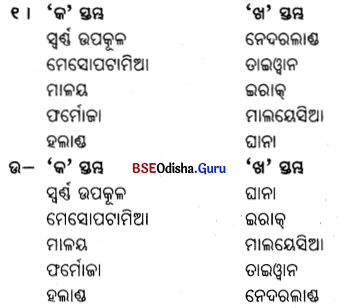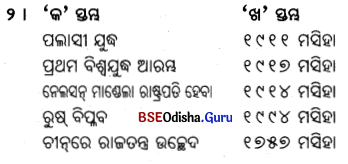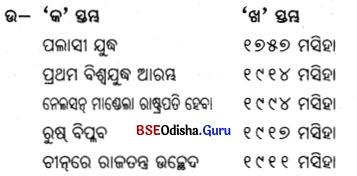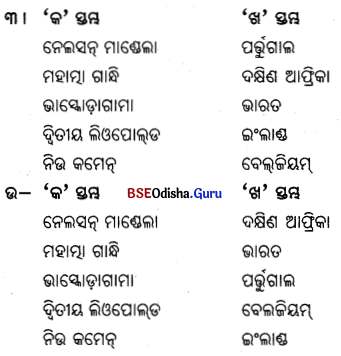Odisha State Board BSE Odisha 9th Class History Important Questions Chapter 3 ରୁଷ ବିପ୍ଲବ : କାରଣ ଓ ଫଳାଫଳ Important Questions and Answers.
BSE Odisha Class 9 History Important Questions Chapter 3 ରୁଷ ବିପ୍ଲବ : କାରଣ ଓ ଫଳାଫଳ
Subjective Type Questions With Answers
ଦୀର୍ଘ ଉତ୍ତରମୂଳକ ପ୍ରଶ୍ନୋତ୍ତର
୧। ୧୯୧୭ ମସିହାର ଫେବୃଆରୀ ବିପ୍ଳବ ସମ୍ପର୍କରେ ଏକ ବିବରଣୀ ଦିଅ ।
Answer:
- ୧୯୧୭ ମସିହା ମାର୍ଚ୍ଚ ମାସ ୮ ତାରିଖରେ ପ୍ରାୟ ଏକ ଲକ୍ଷ ଲୋକ ଓ ହଜାର ହଜାର ମହିଳା ପେଟ୍ରୋଗ୍ରାଡ୍ ସହରର ରାସ୍ତାଘାଟରେ ବିକ୍ଷୋଭ ପ୍ରଦର୍ଶନ କଲେ ।
- ମାର୍ଚ୍ଚ ୧୦ ତାରିଖରେ ଜାର୍ ‘ଡୁମା’କୁ ଭଙ୍ଗ କରିବାରୁ ଡୁମାର ସଦସ୍ୟମାନେ ବିଦ୍ରୋହ କଲେ ଓ କାମଚଳା ସରକାର ଗଠନ କଲେ ଏବଂ ସେଦିନ ସନ୍ଧ୍ୟାରେ ସୈନ୍ୟବାହିନୀ ଓ ବିକ୍ଷୋଭକାରୀମାନଙ୍କୁ ନେଇ ‘ସୋଭିଏତ୍’ ଗଠିତ ।
- ମାର୍ଚ୍ଚ ୧୨ ତାରିଖରେ ବିପ୍ଳବୀମାନେ ଜାରଙ୍କ ସରକାରଙ୍କୁ ହଟାଇ ଏକ କାମଚଳା ସରକାର ପ୍ରତିଷ୍ଠା କଲେ ଓ ଜାର୍ଙ୍କୁ ରାଜଗାଦି ତ୍ୟାଗ ପାଇଁ ବାଧ୍ୟ କଲେ । ମାର୍ଚ୍ଚ ୧୫ ତାରିଖରେ ଜାର୍ ରାଜଗାଦି ତ୍ୟାଗ କଲେ ଏବଂ ରୋମାନୋଭ୍ ରାଜବଂଶ ରାଜତ୍ଵର ଅବସାନ ଘଟିଲା ।
- ସେ ସମୟରେ ରୁଷରେ ପ୍ରଚଳିତ କ୍ୟାଲେଣ୍ଡର ଅନୁଯାୟୀ ମାର୍ଚ୍ଚ ୧୨ ତାରିଖଟି ଫେବୃଆରୀ ୨୭ ତାରିଖ ଥିଲା। ତେଣୁ ଏହାକୁ ଫେବୃଆରୀ ବିପ୍ଳବ କୁହାଯାଏ ।
୨। ଆନ୍ତର୍ଜାତିକ କ୍ଷେତ୍ରରେ ଓ ରୁଷ୍ ଦେଶରେ ରୁଷ୍ ବିପ୍ଳବର ପ୍ରଭାବ ଉଲ୍ଲେଖ କର ।
Answer:
- ରୁଷ୍ ବିପ୍ଲବ ପରେ ରୁଷିଆରୁ ଜାମାନଙ୍କ ଏକଚ୍ଛତ୍ର ବାଦ ଶାସନ ଲୋପ ପାଇ ପ୍ରୋଲେତାରିଏନ୍ଙ୍କ ଶାସନ ପ୍ରତିଷ୍ଠିତ ହେଲା । ରୁ ଷି ଆ ଏକ ଦଳୀୟ ରାଷ୍ଟ୍ର ହେଲା। ଓ ସେଠାରେ ସାମ୍ୟବାଦ ପ୍ରତିଷ୍ଠା ହେଲା ।
- ସମସ୍ତ ଘରୋଇ ଶିଳ୍ପ, କାରଖାନା ଓ ସରକାରୀ ନିୟନ୍ତ୍ରଣରେ ରଖାଗଲା। । ଜମିଗୁଡ଼ିକର ଆବଣ୍ଟନ ପାଇଁ କୃଷକମାନଙ୍କ କମିଟି ଗଠିତ ହେଲା । ଶିଳ୍ପ ଓ କାରଖାନାଗୁଡ଼ିକର ଉତ୍ପାଦନ ଓ ଆବଣ୍ଟନ ବ୍ୟବସ୍ଥା ପରିଚାଳନା ନିମନ୍ତେ ଶ୍ରମିକମାନଙ୍କ କମିଟି ଗଠିତ ହେଲା ।
- ରୁଷରେ ପୁରାତନ ପାଠ୍ୟକ୍ରମ ଓ ଶିକ୍ଷାଦାନ ପଦ୍ଧତିକୁ ବଦଳାଇ ଦିଆଗଲା ଏବଂ ସାମ୍ୟବାଦ ଓ ସମାଜବାଦ ସମ୍ବନ୍ଧରେ ଅଧ୍ୟାକ ଶିକ୍ଷା ଦିଆଗଲା । କଳା ଓ ସ୍ଥାପତ୍ୟ କ୍ଷେତ୍ରରେ ନୂତନତ୍ବ ଦେଖାଦେଲା ।
- ଏହି ବିପ୍ଳବ ପରେ ପୋଲାଣ୍ଡ, ହଙ୍ଗେରୀ, ଯୁଗୋସ୍ଲୋଭିଆ, ରୁମାନିଆ, ବୁଲଗେରିଆ ପ୍ରଭୃତି ଦେଶମାନଙ୍କରେ ସାମ୍ୟବାଦ ପ୍ରତିଷ୍ଠା ଲାଭ କଲା ।
୩। କାର୍ଲ ମାର୍କ କିଏ ? ତାଙ୍କଦ୍ୱାରା ରୁଷ୍କାସୀ କିପରି ପ୍ରଭାବିତ ହୋଇଥିଲେ ?
Answer:
- କାର୍ଲ ମାର୍ଚ୍ଚ ଜଣେ ବୁଦ୍ଧିଜୀବୀ ଥିଲେ । ସେ ୧୯୧୮ ରାଇନ୍ଲାଣ୍ଡରେ ଜନ୍ମଗ୍ରହଣ କରିଥିଲେ ।
- ମାନବଜାତିର ଶୋଷକ ଓ ଶୋଷିତ ବା ପୁଞ୍ଜିପତି ଓ ସର୍ବହରା ଶ୍ରେଣୀରେ ବିଭାଜନ ଏବଂ ସମାଜରେ ହେଉଥିବା ଅବିରତ ଶ୍ରେଣୀ ସଂଘର୍ଷ ସମ୍ପର୍କରେ ସେ ତାଙ୍କ ରଚିତ ପୁସ୍ତକଗୁଡ଼ିକରେ ଆଲୋଚନା କରିଛନ୍ତି ।
- ମାର୍କଙ୍କ ମତାନୁସାରେ ଦେଶର ଜମି ଓ କଳକାରଖାନା ତଥା ଅନ୍ୟାନ୍ୟ ଉତ୍ପାଦକ ସମ୍ପଦର ମାଲିକ ହେଉଛି ସମାଜ ବା ରାଷ୍ଟ୍ର । କୃଷକ ଓ ଶ୍ରମିକଙ୍କ ଝାଳବୁହା ପରିଶ୍ରମରେ ଉତ୍ପାଦିତ ସମ୍ପତ୍ତି କୁ ପୁଞ୍ଜି ପତି ମାନେ ଉପଭୋଗ କରିଥା’ନ୍ତି ଏବଂ ସମାଜରେ ଧନୀକ ଓ ଦରିଦ୍ର ଶ୍ରେଣୀ ସୃଷ୍ଟି କରନ୍ତି ।
- ଏହି ଶୋଷଣ ଓ ବୈଷମ୍ୟ ବିରୋଧରେ ବିପ୍ଳବ କରିବାପାଇଁ କାର୍ଲ ମାର୍କ ପ୍ରୋଲେତାରିଏତ୍ ବା ସର୍ବହରାମାନଙ୍କୁ ଆହ୍ଵାନ ଦେଇଥିଲେ । ମାର୍ଚ୍ଚ ଙ୍କ ଆଦର୍ଶବାଦରେ ଉଦ୍ବୁଦ୍ଧ ହୋଇ ରୁଷିଆର ଜନସାଧାରଣ ସମ୍ଭ୍ରାନ୍ତ ଓ ପୁଞ୍ଜିବାଦୀଙ୍କ ଶୋଷଣ ବିରୋଧରେ ଉଦ୍ବୁଦ୍ଧ ହୋଇ କରିବାକୁ ଆଗେଇ ଆସିଲେ ।
- ତାଙ୍କଦ୍ୱାରା ୧୮୪୮ ମସିହାରେ ରଚିତ ପୁସ୍ତିକା ‘କମ୍ୟୁନିଷ୍ଟ ମାନିଫେଷ୍ଟୋ’ ରୁଷ୍ ବିପ୍ଲବ ପାଇଁ ଇନ୍ଧନ ଯୋଗାଇ ଥିଲା ଓ ରୁଷ୍ ବିପ୍ଳବର କର୍ଣ୍ଣଧାର ଲେନିନ୍ଙ୍କୁ ପ୍ରଭାବିତ କରିଥିଲା ।
![]()
୪ । କେଉଁ ଦିନଟିକୁ ରକ୍ତାକ୍ତ ରବିବାର ବୋଲି କୁହାଯାଏ ଓ କାହିଁକି ?
Answer:
- ୧୯୦୫ ମସିହା ଜାନୁୟାରୀ ୨୨ ତାରିଖ ରବିବାର ଦିନଟିକୁ ରୁଷ୍ ଇତିହାସରେ ରକ୍ତାକ୍ତ ରବିବାର କୁହାଯାଏ ।
- ଏହିଦିନ ଧର୍ମଯାଜକ ଫାଦର ଗ୍ୟାପନ୍ଙ୍କ ନେତୃତ୍ୱରେ ବହୁସଂଖ୍ୟକ ବିକ୍ଷୋଭକାରୀ ଜାର୍ ଦଦ୍ଵିତୀୟ ନିକୋଲାସ୍ଙ୍କୁ ଏକ ଦାବିପତ୍ର ଦେବାପାଇଁ ସେଣ୍ଟ ପିଟର୍ସ୍ଵର୍ଗସ୍ଥିତ ଜାର୍ଙ୍କ ଶୀତକାଳୀନ ପ୍ରାସାଦ ଅଭିମୁଖେ ଏକ ଶୋଭାଯାତ୍ରାରେ ଯାଇଥିଲେ ।
- ଜାର୍ ଙ୍କ ନିର୍ଦ୍ଦେଶରେ ସୈନ୍ୟମାନେ ଶୋଭାଯାଢ୍ତକାଙ୍କ ଉପରେ ଗୁଳିଚାଳନା କରିବା ଫଳରେ ଅନେକ ମୃତୁ ୍ୟବରଣ କରି ଥିଲେ ଓ ବ ହୁ ସଂଖ୍ୟକ ଆହତ ହୋଇଥିଲେ ।
- ଏହି ସମ୍ବାଦ ପ୍ରଚାରିତ ହେବାମାତ୍ରେ ଦେଶସାରା ଧ୍ଵଂସଲୀଳା ଆରମ୍ଭ ହୋଇଗଲା ଏବଂ ଚାରି ଆଡ଼େ ଜନ ଆନ୍ଦୋଳନ ବ୍ୟାପିଗଲା ।
- ଏହି ଘଟଣାଟି ଜାର୍ଙ୍କ ସ୍ଵେଚ୍ଛାଚାରୀ ଶାସନ ବିରୋଧରେ ସଙ୍ଗଠିତ ହୋଇ ବିଦ୍ରୋହ କରିବାକୁ ରୁଷ୍ବାସୀଙ୍କୁ ପ୍ରେରଣା ଦେଇଥିଲା ।
୫। ରୁଷ୍ ଶାସନ କାର୍ଯ୍ୟରେ ଜାରିନା ଆଲେକ୍ଜାଣ୍ଡ୍ରା ଓ ରାସପୁଟିନ୍ ଙ୍କ ହସ୍ତକ୍ଷେପ ରୁଷ୍ ବିପ୍ଳବର ଅନ୍ୟତମ କାରଣ ଥିଲା – ଆଲୋଚନା କର ।
କିମ୍ବା, ରୁଷ୍ ଦେଶର ଜନସାଧାରଣ ଦେଶର ଶାସନ ବ୍ୟବସ୍ଥାକୁ ପରିବର୍ତ୍ତନ କରିବାପାଇଁ କାହିଁକି ସଂକଳ୍ପବଦ୍ଧ ହେଲେ ?
କିମ୍ବା, ରୁଷ୍ ବିପ୍ଲବରେ ଜାରିନା ଆଲେକ୍ଜାଣ୍ଡ୍ରାଙ୍କ ଭୂମିକା କିପରି ଥୁଲା ? ସେ ଶାସନ କ୍ଷେତ୍ରରେ କାହା ସହିତ ହାତ ମିଳାଇଥିଲେ ?
Answer:
- ଜାର୍ ଦ୍ଵିତୀୟ ନିକୋଲାସ୍କଙ୍କ ପତ୍ନୀ ଜାରିନା ଆଲେକ୍ ଜାଣ୍ଡ୍ରା ଜଣେ ସ୍ଵେଚ୍ଛାଚାରୀ, ଅହଂକାରୀ ଓ ସଂକୀର୍ଣ୍ଣମନା ନାରୀ ଥିଲେ ।
- ଅତ୍ୟନ୍ତ କ୍ଷମତାଲୋଭୀ ଜାରିନା ସବୁବେଳେ ଜାର୍ ଦ୍ୱିତୀୟ ନିକୋଲାସ୍ଙ୍କୁ ନିରଙ୍କୁଶ ଓ କଠୋର ଶାସନ କରିବାପାଇଁ ପ୍ରରୋଚିତ କରୁଥିଲେ ।
- ସେ ଅନ୍ଧବିଶ୍ୱାସର ଶିକାର ହୋଇ ଜଣେ ଭଣ୍ଡ ସନ୍ନ୍ୟାସୀ ଗ୍ରୀଗୋରୀ ଏଫି ମୋଭିଚ୍ ବା ରାସ୍ପୁଟିନ୍ ଜାର୍ ଏବଂ ତାଙ୍କ ଶାସନ ଉପରେ ହୋଇଗଲେ । ଜାରିନାଙ୍କ ଜରିଆରେ ଅଖଣ୍ଡ ପ୍ରଭାବ ବିସ୍ତାର କରିଥିଲେ ।
- ସେ ସମସ୍ତ ରାଜକାର୍ଯ୍ୟରେ ହସ୍ତକ୍ଷେପ କରୁ ଥିଲେ, ଯାହାକୁ ଚାହିଁଲେ ତାକୁ ମନ୍ତ୍ରୀମଣ୍ଡଳରୁ ବହିଷ୍କାର କରୁଥିଲେ, ନିଜ ମନମୁତାବକ ଉଇ ପଦପଦବାରେ ନିଜ ଲୋକଙ୍କୁ ରଖୁଥିଲେ ।
- ତାଙ୍କର ପ୍ରଭାବ ସାରା ଦେଶରେ ଦୁର୍ନୀତି ଓ ବିଭ୍ରାନ୍ତକର ବାତାବରଣ ସୃଷ୍ଟି କରିଥିଲା । ଫଳରେ ଜନସାଧାରଣ ରାଜପରିବାର ପ୍ରତି ଅସନ୍ତୁଷ୍ଟ ହୋଇ ଦେଶର ଶାସନ ବ୍ୟବସ୍ଥାକୁ ପରିବର୍ତ୍ତନ କରିବାପାଇଁ ସଂକଳ୍ପବଦ୍ଧ ହେଲେ ।
୬। ପ୍ରଥମ ବିଶ୍ଵଯୁଦ୍ଧରେ ରୁଷ୍ କାହିଁକି ପରାଜିତ ହୋଇଥିଲା ?
Answer:
ନିମ୍ନଲିଖିତ କାରଣଗୁଡ଼ିକ ଯୋଗୁଁ ରୁଷ୍ ପ୍ରଥମ ବିଶ୍ବଯୁଦ୍ଧରେ ପରାଜୟ ସ୍ବୀକାର କରିଥିଲା ।
- ଦେଶର ଆଭ୍ୟନ୍ତରୀଣ ସମାସ୍ୟ।ଗୁଡ଼ିକର ସମାଧାନ ନିମନ୍ତେ କୌଣସି ଉଲ୍ଲେଖନୀୟ ପଦକ୍ଷେପ ନେବା ପରିବର୍ତ୍ତେ ରୁଷ୍ୟାସୀଙ୍କ ପ୍ରବଳ ବିରୋଧ ସତ୍ତ୍ଵେ ପ୍ରଥମ ବିଶ୍ଵଯୁଦ୍ଧରେ ରୁଷିଆ ଜର୍ମାନୀ ବିରୋଧରେ ମିତ୍ରଶକ୍ତି ସପକ୍ଷରେ ଯୋଗ ଦେଇଥିଲା ।
- ଯୁଦ୍ଧ ପାଇଁ ରୁଷିଆର ଉପଯୁକ୍ତ ପ୍ରସ୍ତୁତି ନ ଥିଲା ।
- ରୁଷୀୟ ସୈନ୍ୟମାନେ ନିରୁତ୍ସାହିତ ଥିଲେ ଏବଂ ସେମାନଙ୍କ ମନୋବଳ ଦୃଢ଼ ନ ଥିଲା ।
- ରୁ ଷୀୟ ସୈନ୍ୟବାହି ନୀ କେନ୍ଦ୍ରଶକ୍ତିର ସୈନ୍ୟବାହିନୀର ସମ୍ମୁଖୀନ ହେବା ପାଇଁ ଅକ୍ଷମ ଥିଲା ।
- ଫଳରେ ଯୁଦ୍ଧ ଆରମ୍ଭରୁ ହିଁ ରୁଷୀୟ ସୈନ୍ୟ ପ୍ରାଣ ହରାଇଲେ ଏବଂ ବନ୍ଦୀ ହୋଇଥିଲେ ।
୭ । ରୁଷ୍ ବିପ୍ଳବର ମୁଖ୍ୟ କାରଣଗୁଡିକ ଉଲ୍ଲେଖ କର ।
Answer:
- ବିଭିନ୍ନ କାରଣରୁ ଉପୁଜିଥିବା ଜନ ଅସନ୍ତୋଷ ପୁଞ୍ଜୀଭୂତ ହୋଇ ଏକ ବିପ୍ଳବ କରିବା ସପକ୍ଷରେ ରୁ ଷି ଆରେ ଜନମତ ସୃଷ୍ଟି ହୋଇଥିଲା ।
- ଖାଦ୍ୟଶସ୍ୟ, ପୋଷାକ, ଜାଳେଣି ପ୍ରଭୃତି ଦୈନନ୍ଦିନ ଆବଶ୍ୟକତାର ଅଭାବ ରୁଷ୍ ବିପ୍ଳବର ଆଶୁ କାରଣ ହେଲା । ଜିନିଷପତ୍ରର ଦରଦାମ୍ ବୃଦ୍ଧି ଯୋଗୁଁ ଗରିବ ଲୋକମାନେ ଦୟନୀୟ ଜୀବନ ଅତିବାହିତ କଲେ ।
- ରୁଷିଆରେ ଅରାଜକତା ଓ ବିଶୃଙ୍ଖଳ ପରିସ୍ଥିତି ପ୍ରତି ଜାର୍ ଦ୍ଵିତୀୟ ନିକୋଲାସ୍ ଉଦାସୀନ ଥିଲେ । ସେ ବଜାରରେ ଜିନିଷପତ୍ରର ଅଭାବ ଦୂର କରିବାପାଇଁ ଉଚିତ ପଦକ୍ଷେପ ନେଲେ ନାହିଁ ।
- ଫଳରେ ଲୋକମାନେ ନିଜର ଦୁର୍ଦ୍ଦଶା ପାଇଁ ଜାର୍ଙ୍କୁ ଦାୟୀ କରିବା ସହ ବିପ୍ଳବର ପନ୍ଥାକୁ ଆଦରି ନେଲେ ।
୮। କେରେନ୍ସ୍କି ସରକାର ଶାସନ କ୍ଷେତ୍ରରେ କାହିଁକି ବିଫଳ ହୋଇଥିଲା ?
Answer:
- କାମଚଳା ସରକାରଙ୍କର ବିଫଳତା ପରେ ରୁଷିଆରେ ମେନସେଭିକ୍ ଦଳ କ୍ଷମତାକୁ ଆସିଲା ଏବଂ ଏହାର ପ୍ରଧାନମନ୍ତ୍ରୀ ଥିଲେ କେରେନ୍ ସ୍କି । ସେ ସମାଜବାଦ ପ୍ରତିଷ୍ଠା ପାଇଁ ସାମ୍ବିଧାନିକ ପନ୍ଥାରେ ବିଶ୍ଵାସ କରୁ ଥିଲେ ।
- ସେ ଯୁଦ୍ଧ ଚାଲୁ ରହିବା ସପକ୍ଷରେ ଥିଲେ ଏବଂ ରୁଷୀୟ ସୈନ୍ୟମାନଙ୍କ ମଧ୍ୟରେ ସାହସ ଓ ମନୋବଳକୁ ସେ ଦୃଢ଼ କରିବାକୁ ଉଦ୍ୟମ କରି ବିଫଳ ହୋଇଥିଲେ । ଫଳରେ କ୍ଷିପ୍ର ଗତିରେ ରୁଷି ଆ ଆଡ଼କୁ ଆସୁଥିବା ଜର୍ମାନୀ ସୈ ନ୍ୟମାନଙ୍କୁ ରୁ ଷୀୟ ସୈନ୍ୟମାନେ ଅଟକାଇ ପାରିନଥିଲେ ।
- ପୁନଶ୍ଚ ଗୁରୁତ୍ଵପୂର୍ଣ୍ଣ ରିଗା ସହର ଜର୍ମାନୀ ପେଟ୍ରୋଗ୍ରାଡ୍ ସହର ପାଇଁ ବିପଦ ସୃଷ୍ଟି ପେଟ୍ରୋଗ୍ରାଡ୍ ସହର ପାଇଁ ବିପଦ ସୃଷ୍ଟି ହେଲା ।
- ବହୁ ଯୁଦ୍ଧକ୍ଷେତ୍ରରେ ରୁଷୀୟ ସୈନ୍ୟବାହିନୀର ଲଗାତର ପରାଜୟ ଯୋଗୁଁ ରୁ ଷୀୟ ଲୋକମାନଙ୍କ ମନରେ ଅସନ୍ତୋଷ ଜନ୍ମିଲା ।
- କେରେନ୍ସ୍କି ସରକାର ରୁଷିବାସୀଙ୍କର ମୂଳ ଉଦ୍ଦେଶ୍ୟକୁ ପୂରଣ କରିବା ଦିଗରେ ବିଫଳ ହୋଇଥିଲେ । ଫଳରେ ଏହା ବିରୋଧରେ ‘ବୋଲ୍ସେଭିକ୍ ବିପ୍ଲବ’ ସଂଘଟିତ ହେଲା ।
![]()
୯। ରୁଷ୍ ବିପ୍ଳବ ରାଜନୈତିକ କ୍ଷେତ୍ରରେ କି କି ପରିବର୍ତ୍ତନ ଆଣିଥିଲା ?
Answer:
ରୁଷ୍ ବିପ୍ଳବ ରାଜନୈତିକ କ୍ଷେତ୍ରରେ ନିମ୍ନଲିଖିତ ପରିବର୍ତ୍ତନ ଆଣିଥିଲା
- ଦେଶରୁ ଜାମାନଙ୍କ ଏକଚ୍ଛତ୍ର ଶାସନ ଲୋପ ପାଇଲା । ଦେଶର ଶାସନ ପ୍ରୋଲେତାରିଏନ୍ଙ୍କ ହାତକୁ ଗଲା ।
- ପ୍ରଶାସନକୁ ପରିଚାଳିତ କରିବାପାଇଁ ସହର ଓ ଜିଲ୍ଲା ସ୍ତରରେ ‘ସୋଭିଏତ୍’ ଗଠିତ ହେଲା । ପ୍ରଦେଶ ସ୍ତରୀୟ ‘ସୋଭିଏତ୍ ’ ଏବଂ କଂଗ୍ରେସ’ ଗଠିତ ହେଲା ।
- ଏହା ରୁଷ୍ ଦେଶର ସଂସଦ ଭାବରେ କାର୍ଯ୍ୟ କଲା । ସର୍ବ-ରୁଷୀୟ ସୋଭିଏତ୍ କଂଗ୍ରେସ ନିର୍ବାଚନରେ କେବଳ ବୋଲ୍ସେଭିକ୍ ଦଳ ଅଂଶଗ୍ରହଣ କଲା । ଫଳରେ ରୁଷିଆ ଗୋଟିଏ ଏକଦଳୀୟ ରାଷ୍ଟ୍ର ହେଲା ।
- ବୋଲ୍ସେଭିକ୍ ଦଳ ‘ରୁଷୀୟ କମ୍ୟୁନିଷ୍ଟ ଦଳ’ ନାମରେ ପୁନର୍ନାମିତ ହୋଇଥିଲା । ୧୯୧୮ ମସିହା ସମ୍ବିଧାନରେ ରୁଷିଆକୁ ‘ରୁଷୀୟ ସୋସିଆଲିଷ୍ଟ ଫେଡ଼େରେଟିଭ ସୋଭିଏତ୍ ରିପବ୍ଲିକ୍’ ଭାବେ ନାମିତ କରାଗଲା ।
- ୧୯୨୪ ମସିହାର ସମ୍ବିଧାନ ଅନୁଯାୟୀ ରୁଷିଆର ନାମକୁ ପରିବର୍ତ୍ତନ କରାଯାଇ ଏହାକୁ ‘ୟୁନି ଅନ୍ ଅଫ୍ ସୋଭିଏତ୍ ସୋସିଆଲିଷ୍ଟ ରିପବ୍ଲିକ୍ସ୍’ ନାମରେ ନାମିତ କରାଗଲା ।
୧୦ । ରୁଷ୍ ବିପ୍ଳବ ଅର୍ଥନୈତିକ କ୍ଷେତ୍ରରେ କି ପ୍ରକାର ପରିବର୍ତ୍ତନ ଆଣିଥିଲା, ସଂକ୍ଷେପରେ ଲେଖ ।
Answer:
- ରୁଷ୍ ବିପ୍ଲବ ପରେ ସମସ୍ତ ଘରୋଇ ଶିଳ୍ପ, କାରଖାନା ତଥା ବ୍ୟାଙ୍କଗୁଡ଼ିକର ଜାତୀୟକରଣ ହେଲା ଏବଂ ସେଗୁଡ଼ିକ ସରକାରଙ୍କ ନିୟନ୍ତ୍ରଣାଧୀନ ହେଲା ।
- ଜମିଗୁଡ଼ିକୁ ଜାତୀୟକରଣ କରାଯାଇଥିଲା ଓ ଜମିଦାର ମାନଙ୍କଠାରୁ ଜମିର ସ୍ଵତ୍ଵ କାଢ଼ି ନିଆଗଲା ।
- ଦେଶର ସମସ୍ତ ସମ୍ପଦକୁ ରାଷ୍ଟ୍ରୀୟ ସମ୍ପଭି ରୂପେ ଘୋଷଣା କରାଯାଇଥିଲା ।
- ଶିଳ୍ପ ଓ କାରଖାନାମାନଙ୍କରେ ଉତ୍ପାଦନ ଓ ଆବଣୢନ ବ୍ୟବସ୍ଥ।କୁ ପରିଚାଳନା କରିବାପାଇଁ ଶ୍ରମିକମାନଙ୍କ କମିଟି ଗଠିତ ହେଲା ।
- ଏହିପରି ଭାବରେ ପୁଞ୍ଜିବାଦର ଅବସାନ ହେଲା ଓ ସାମ୍ୟବାଦର ଉତ୍ଥାନ ହେଲା ।
କ୍ଷୁଦ୍ର ଉତ୍ତରମୂଳକ ପ୍ରଶ୍ନୋତ୍ତର
୧ । ଜାର୍ ଶାସନ କାଳରେ ରୁଷ୍ଠରେ ଶ୍ରମିକମାନେ କ’ଣ ପାଇଁ ମୃତ୍ୟୁବରଣ କରୁଥିଲେ ?
Answer:
(i) ଜାର୍ ଶାସନ କାଳରେ ରୁଷ୍ଠରେ ଶ୍ରମିକମାନେ ସହରର ଅସ୍ଵାସ୍ଥ୍ୟକର ପରିବେଶରେ ଛୋଟ ଛୋଟ ଘରେ ରହୁଥିଲେ ଓ ‘ଭୋଦ୍’ ନାମକ ନିଶାକାରୀ ପାନୀୟ ପ୍ରତି ଆସକ୍ତ ଥିଲେ ।
(ii) ଅସ୍ବାସ୍ଥ୍ୟକର ପରିବେଶ, କ୍ଷୁଧା ଓ ନିଶାଦ୍ରବ୍ୟ ସେବନ ଯୋଗୁଁ ଅନେକ ଶ୍ରମିକ ରୋଗାକ୍ରାନ୍ତ ହୋଇ ମୃତ୍ୟୁବରଣ କରୁଥିଲେ । ଜାର୍ ସେମାନଙ୍କ ଉନ୍ନତି ପାଇଁ କୌଣସି ପଦକ୍ଷେପ ନେଉନଥିଲେ ।
୨। ରୁଷ୍ ଦେଶରେ ଦ୍ୱିତୀୟ ଥର ପାଇଁ ସମ୍ବିଧାନ କେବେ ଗୃହୀତ ହେଲା ? ଏହି ସମ୍ବିଧାନ ଅନୁଯାୟୀ ରୁଷ୍ ନାମ କ’ଣ ହେଲା ?
Answer:
(i) ରୁଷ୍ ଦେଶରେ ୧୯୨୪ ମସିହାରେ ଦ୍ଵିତୀୟ ଥର ପାଇଁ ସମ୍ବିଧାନ ଗୃହୀତ ହେଲା ।
(ii) ଏହି ସମ୍ବିଧାନ ଅନୁଯାୟୀ ରୁ ଷ୍ଠ ନାମ ପରିବର୍ତ୍ତିତ ହୋଇ ‘ୟୁନିଅନ୍ ଅଫ୍ ସୋଭିଏତ୍ ସୋସିଆଲିଷ୍ଟ ରିପବ୍ଲିକ୍ସ୍’ ହେଲା ।
୩। କୃଷିଭୃତ୍ୟ ପ୍ରଥା କ’ଣ ? ଏହାକୁ କିଏ କେବେ ଉଚ୍ଛେଦ କରିଥିଲେ ?
Answer:
(i) ଜାର୍ ଶାସନ କାଳରେ ରୁଷ୍ଠରେ ‘କୃଷି -ଭୃତ୍ୟ’ ନାମକ ଏକ ଘୃଣ୍ୟ ପ୍ରଥା ପ୍ରଚଳିତ ଥିଲା ।
(ii) ୧୮୬୧ ଖ୍ରୀ.ଅ.ରେ ଜାର୍ ଦ୍ଵିତୀୟ ଆଲେକ୍ ଜାଣ୍ଡାର ଏହି ପ୍ରଥା ଉଚ୍ଛେଦ କରିଥିଲେ ।
୪। ରୁଷ୍ ବିପ୍ଳବ ସମୟରେ ବୋଲ୍ସେଭିକ୍ ଦଳର ନେତା କିଏ ଥିଲେ ? ତାଙ୍କର ପ୍ରଧାନ ଲକ୍ଷ୍ୟ କ’ଣ ଥିଲା ?
Answer:
(i) ରୁଷ୍ ବିପ୍ଳବ ସମୟରେ ବୋଲ୍ସେଭିକ୍ ଦଳର ନେତା ଥିଲେ ।
(ii) ବୈପ୍ଳବିକ ଉପାୟରେ ଜାର୍ ଶାସନର ବିଲୋପ ଘଟାଇ ରୁଷିଆରେ ପ୍ରୋଲେତାରିଏତ୍ ଶାସନ ପ୍ରତିଷ୍ଠା କରିବା ତାଙ୍କର ପ୍ରଧାନ ଲକ୍ଷ୍ୟ ଥିଲା ।
୫। ‘‘ଫେବୃଆରୀ ବିପ୍ଳବ’’ କାହାକୁ କୁହାଯାଏ ?
Answer:
(i) ୧୯୧୭ ମସିହା ମାର୍ଚ୍ଚ ୮ ତାରିଖରେ ପେଟ୍ରୋଗ୍ରାଡ୍ ସହରରେ ପ୍ରାୟ ଏକ ଲକ୍ଷ ଲୋକ ବିଦ୍ରୋହ ଆରମ୍ଭ କଲେ ଏବଂ ୧୨ ତାରିଖରେ ଜାରି ଓ ତାଙ୍କ ସରକାରଙ୍କୁ କ୍ଷମତାରୁ ହଟାଇ କାମଚଳା ସରକାର ଗଠନ କଲେ ।
(ii) ରୁଷ୍ ଦେଶର ସେ ସମୟର ବର୍ଷପଞ୍ଜିକା ଅନୁସାରେ ଫେବୃଆରୀ ୨୭ ତାରିଖ ଦିନ ଜାର୍ ଶାସନର ପତନ ହୋଇଥିବାରୁ ଏହାକୁ ଫେବୃଆରୀ ବିପ୍ଳବ କୁହାଯାଏ ।
୬। ଲେନିନ୍ଙ୍କ ନେତୃତ୍ଵରେ ଗଢ଼ାଯାଇଥିବା ସରକାର ଦେଶରେ ସାମ୍ୟବାଦୀ ସମାଜ ଗଠନ ନିମନ୍ତେ ନେଉଥ୍ ବା ପଦଷେପଗୁଡ଼ଁକ ମଧ୍ୟରୁ ଯେକୈଣସି ଦୁଇଟିର ଉଲ୍ଲେଖ କର ।
Answer:
(i) ଲେନିନ୍ଙ୍କ ନେତୃତ୍ଵରେ ଗଢ଼ାଯାଇଥିବା ସରକାର ଦେଶରେ ସାମ୍ୟବାଦୀ ସମାଜ ଗଠନ ପାଇଁ ଜମିଦାରଙ୍କଠାରୁ ଜମିର ସ୍ଵତ୍ଵ କାଢ଼ିନେଇ ଜମିର ଜାତୀୟକରଣ କରି ସେଗୁଡ଼ିକର ଉପଯୁକ୍ତ ଆବଶୂନ ପାଇଁ କୃଷକମାନ କମିଟି ଗଠନ କରିଥିଲା ।
(ii) ଶିଳ୍ପ ଓ କାରଖାନାମାନଙ୍କର ଉତ୍ପାଦନ ଓ ଆବଶୂନ ବ୍ୟବସ୍ଥ।କୁ ପରିଚାଳନା କରିବାପାଇଁ ଶ୍ରମିକମାନଙ୍କ କମିଟି ଗଠନ କରିଥିଲା ।
୭ । ଫେବୃଆରୀ ବିପ୍ଳବର ଫଳାଫଳ କ’ଣ ହେଲା ?
Answer:
(i) ଫେବୃଆରୀ ବିପ୍ଳବର ଫଳାଫଳସ୍ବରୂପ ଜାର୍ ଓ ତାଙ୍କ ସରକାର କ୍ଷମତାରୁ ଅପସରି ଗଲେ ଏବଂ ୧୯୧୭ ମସିହା ମାର୍ଚ୍ଚ ୧୨ ତାରିଖରେ କାମଚଳା ସରକାର ପ୍ରତିଷ୍ଠା ହେଲା ।
(ii) ୧୯୧୭ ମସିହା ମାର୍ଚ୍ଚ ୧୫ ତାରିଖରେ ଜାର୍ ଦ୍ଵିତୀୟ ନିକୋଲାସ୍ ସିଂହାସନ ତ୍ୟାଗ କରିବାକୁ ବାଧ୍ୟ ହେଲେ ।
![]()
୮। ‘ସାମାଜିକ ବିପ୍ଳବୀ ଦଳ’ କେଉଁମାନେ କେବେ ଗଠନ କରିଥିଲେ ଓ କାହିଁକି ?
(i) ରୁଷ୍ ଭୂମିହୀନ କୃଷକମାନେ ୧୯୦୧ ମସିହାରେ ‘ସାମାଜିକ ବିପ୍ଳବୀ ଦଳ’ ଗଠନ କରିଥିଲେ ।
(ii) ସମ୍ଭ୍ରାନ୍ତ ମାନଙ୍କଠାରୁ ଜମି ଛଡ଼ାଇ ଆଣି କୃଷକମାନଙ୍କ ମଧ୍ୟରେ ବଣ୍ଟନ କରିବା ଏହି ଦଳର ମୁଖ୍ୟ ଲକ୍ଷ୍ୟ ଥିଲା ।
୯। ଫରାସୀ ବିପ୍ଳବ ଏବଂ ରୁଷ୍ ବିପ୍ଳବ ମଧ୍ୟରେ ଥିବା ଦୁଇଟି ପାର୍ଥକ୍ୟ ଦର୍ଶାଅ ।
Answer:
(i) ଫରାସୀ ବିପ୍ଳବ ୧୭୮୯ ମସିହାରେ ସଂଘଟିତ ଦେ।ଇଥ୍ ଳାବେଳେ ରୁଷ ବିପବ୧୯୧୭ ମସିହାରେ ସଂଘଟିତ ହୋଇଥିଲା ।
(ii) ଫରାସୀ ବିପ୍ଳବ ସାରା ବିଶ୍ଵକୁ ମୁକ୍ତି, ସାମ୍ୟ ଓ ମୈତ୍ରୀର ବାର୍ତ୍ତା ଦେଇଥିଲାବେଳେ ରୁଷ୍ ବିପ୍ଳବ ସାମ୍ୟବାଦ, ସମାଜବାଦ ଓ ସମତାର ବାର୍ତ୍ତା ପ୍ରସାରଣ କରିଥିଲା । ଏହା ପୃଥିବୀର ଅନେକ ଦେଶରେ ସାମାଜିକ ଓ ଅର୍ଥନୈତିକ କ୍ଷେତ୍ରରେ ବ୍ୟାପକ ପରିବର୍ତ୍ତନ ଆଣିବାରେ ସହାୟକ ହୋଇଥିଲା ।
୧୦ । ରୁଷ୍ ବିପ୍ଳବ ପୂର୍ବରୁ ରୁଷର ଆଇନକାନୁନ କ’ଣ ଥିଲା ? ଦେଶରେ କି ପ୍ରକାର ଶାସନ ପ୍ରଚଳିତ ଥିଲା ?
Answer:
(i) ରୁଷ୍ ବିପ୍ଳବ ପୂର୍ବରୁ ରୁଷରେ ଆଇନକାନୁନ କିଛି ନ ଥିଲା । ସମ୍ରାଟ ନିଜର ଇଚ୍ଛାନୁଯାୟୀ ଲୋକଙ୍କୁ ବନ୍ଦୀ କରି ପାରୁଥିଲେ ଏବଂ ବରଫାବୃତ ସାଇବେରିଆକୁ ନିର୍ବାସିତ କରିପାରୁଥିଲେ ।
(ii) ବିନା ବିଚାରରେ ଲୋକଙ୍କୁ ମୃତ୍ୟୁଦଣ୍ଡର ଆଦେଶ ଦିଆଯାଉଥିଲା । ଦେଶରେ ସ୍ବେଚ୍ଛାଚାରୀ ଶାସନ ପ୍ରଚଳିତ ଥିଲା ।
୧୧ । ରୁଷ୍ ବିପ୍ଳବ ପୂର୍ବରୁ ଶହେ ବର୍ଷରୁ ଊର୍ଦ୍ଧ୍ବ ସମୟ ରୁଷ୍ କେଉଁ ବଂଶର କେତେ ଜଣ ଜାର୍ ଶାସନ କରିଥିଲେ ? ସେମାନେ ଦେଶରେ କି ପ୍ରକାର ଶାସନ ଚଳାଇଥିଲେ ?
Answer:
(i) ରୁଷ୍ ବିପ୍ଳବ ପୂର୍ବରୁ ଶହେ ବର୍ଷରୁ ଊର୍ଦ୍ଧ୍ୱ ସମୟ ରୁଷକୁ ରୋମାନୋଭ୍ ବଂଶର ପାଞ୍ଚଜଣ ଜାର୍ ଶାସନ କରିଥିଲେ ।
(ii) ସେମାନେ ଦେଶରେ ସ୍ଵେଚ୍ଛାଚାରୀ ଶାସନ ଚଳାଇଥିଲେ ।
୧୨ । ଜାର୍ ଦ୍ୱିତୀୟ ଆଲେକ୍ଜାଣ୍ଡାର କିଏ ? ସେ ରୁଷ୍ ପାଇଁ କ’ଣ କରିଥିଲେ ? ତାଙ୍କର ମୃତ୍ୟୁ କିପରି ହୋଇଥିଲା ?
Answer:
(i) ଜାର୍ ଦ୍ବିତୀୟ ଆଲେକ୍ଜାଣ୍ଡାର ୧୮୫୫ ରୁ ୧୮୮୧ ଖ୍ରୀ.ଅ. ପର୍ଯ୍ୟନ୍ତ ରୁଷିଆର ସମ୍ରାଟ ଥିଲେ ।
(ii) ସେ ଦେଶରୁ ଦାସତ୍ଵ ଓ କୃଷିଭୃତ୍ୟ ପ୍ରଥା ଦିଆଯାଉଥିଲା । ଦେଶରେ ସ୍ବେଚ୍ଛାଚାରୀ ଶାସନ କେତେକ ଉଦାର ନୀତି ଅବଲମ୍ବନ କରିଥିଲେ ମଧ୍ୟ ରାଜତ୍ଵର ଶେଷଭାଗରେ ଦମନମୂଳକ ନୀତି ପ୍ରବର୍ତ୍ତନ କରି ଜଣେ ଆତତାୟୀଦ୍ଵାରା ନିହତ ହୋଇଥିଲେ ।
୧୩ । ମୁକ୍ତିଦାତା ଜାର୍ କାହାକୁ କୁହାଯାଏ କାହିଁକି ?
Answer:
(i) ଜାର୍ ଦ୍ୟିତୀୟ ଆଳେକ୍ଜା ଣ୍ଡ।ରଙ୍କୁ ମୁକ୍ତିଦାତା ଜାର୍ କୁହାଯାଏ ।
(ii) କାରଣ ସେ ୧୮୬୧ ମସିହାରେ ଦାସତ୍ଵ ମୋଚନ ରାଜା ଜ୍ଞା ରାଜାଜ୍ଞା ଘୋଷଣା କରି କୃଷିଭୃତ୍ୟମାନଙ୍କୁ ମୁକ୍ତ କରିଥିଲେ ଏବଂ ସେମାନଙ୍କୁ ସାମାଜିକ ଅଧିକାର ପ୍ରଦାନ କରିଥିଲେ ।
୧୪ । ରୁଷୀୟ ସମାଜ କେତେ ଭାଗରେ ଓ କେଉଁ କେଉଁ ନାମରେ ବିଭକ୍ତ ହୋଇଥିଲା ? ଜାର୍ ଙ୍କ ଏକଚ୍ଛତ୍ରବାଦ ଶାସନକୁ କେଉଁମାନେ ସମର୍ଥନ କରୁଥିଲେ ?
Answer:
(i) ରୁଷୀୟ ସମାଜ ୨ ଭାଗରେ ଯଥା ଥିଲାବାଲା ଶ୍ରେଣୀ ଓ ନ ଥିଲାବାଲା ଶ୍ରେଣୀରେ ବିଭକ୍ତ ହୋଇଥିଲା ।
(ii) ଜାରଙ୍କ ଏକଚ୍ଛତ୍ରବାଦ ଶାସନକୁ ଥିଲାବାଲା ଶ୍ରେଣୀର ଧନିକ ଗୋଷ୍ଠୀର ଲୋକମାନେ ସମର୍ଥନ କରୁଥିଲେ ।
୧୫ । ସର୍ବହରାମାନେ କେଉଁ ନାମରେ ପରିଚିତ ଥିଲେ ? ସେମାନେ କିପରି ସର୍ବହରା ହେଲେ ?
Answer:
(i) ସର୍ବହରାମାନେ ‘ପ୍ରୋଲେତାରିଏତ୍’ ନାମରେ ପରିଚିତ ଥିଲେ ।
(ii) ପ୍ରତ୍ୟକ୍ଷ କର ଦେବା ସହିତ ଜମି ବାବଦ ଅର୍ଥ ସରକାରଙ୍କୁ ଦେବାଦ୍ଵାରା ଲୋକମାନଙ୍କ ଆର୍ଥିକ ଅବସ୍ଥା ଦୁର୍ବଳ ହେଲା । ଚାଷଜମିର ଆବଣ୍ଟନ ଠିକ୍ ଭାବରେ ନ ହେବାରୁ ଲୋକମାନେ ଭୂମିହୀନ ହେଲେ । ଫଳରେ ସେମାନେ ସର୍ବହରା ହୋଇଗଲେ ।
୧୬ । ସର୍ବହରାମାନଙ୍କୁ କିଏ କାହିଁକି ଆହ୍ବାନ ଦେଇଥିଲେ ? ସେମାନେ କ’ଣ କରିବାକୁ ଆଗେଇ ଆସିଥିଲେ ?
Answer:
(i) କାର୍ଲ ମାର୍କ ଶୋଷଣ ଓ ବୈଷମ୍ୟ ବିରୋଧରେ ବିପ୍ଳବ କରିବାପାଇଁ ସର୍ବହରାମାନଙ୍କୁ ଆହ୍ଵାନ ଦେଇଥିଲେ।
(ii) ମାର୍କଙ୍କ ଆଦର୍ଶବାଦରେ ଉଦ୍ବୁଦ୍ଧ ହୋଇ ସମ୍ଭ୍ରାନ୍ତ ଓ ପୁଞ୍ଜିବାଦୀଙ୍କ ଶୋଷଣ ବିରୋଧରେ ବିପ୍ଳବ କରିବାକୁ ସେମାନେ ଆଗେଇ ଆସିଥିଲେ ।
୧୭ । କାର୍ଲ ମାର୍କ କେବେ ଓ କେଉଁଠାରେ ଜନ୍ମଗ୍ରହଣ କରିଥିଲେ ? ତାଙ୍କ ରଚିତ ଦୁଇଟି ପୁସ୍ତକର ନାମ ଲେଖ।
Answer:
(i) କାର୍ଲ ମାର୍ଚ୍ଚ ୧୮୧୮ ମସିହାରେ ଜର୍ମାନ୍ର ରାଇନ୍ଲାଣ୍ଡରେ ଜନ୍ମଗ୍ରହଣ କରିଥିଲେ।
(ii) ୧୮୪୮ରେ ସେ ‘କମ୍ୟୁନିଷ୍ଟ ମାନିଫେଷ୍ଟା’ ଓ ୧୮୬୭ରେ ‘ଦ କ୍ୟାପିଟାଲ’ ନାମକ ଦୁଇଟି ବୈପ୍ଳବିକ ଚିନ୍ତାଧାରା ସମ୍ବଳିତ ପୁସ୍ତକ ରଚନା କରିଥିଲେ ।
୧୮ । ବୋଲ୍ସେଭିକ୍ ଦଳ ଦେଶରେ କେଉଁ ଶାସନ ପ୍ରତିଷ୍ଠା କରିବାକୁ ଚାହୁଁଥିଲା ? ଏହି ଦଳର ନେତୃତ୍ବ କିଏ ନେଇଥିଲେ ?
(i) ବୋଲ୍ସେଭିକ୍ ଦଳ ବୈପ୍ଳବିକ ଉପାୟରେ ଜାର୍ ଶାସନର ବିଲୋପ ଘଟାଇ ଦେଶରେ ପ୍ରୋଲେତାରିଏତ୍ ଶାସନ ପ୍ରତିଷ୍ଠା କରିବାକୁ ଚାହୁଁଥିଲା ।
(ii) ଲେନିନ୍ ଏହି ଦଳର ନେତୃତ୍ୱ ନେଇଥିଲେ ।
![]()
୧୯ । ଲେନିନ୍ କେବେ ଓ କେଉଁଠାରେ ଜନ୍ମଗ୍ରହଣ କରିଥିଲେ ? ତାଙ୍କର ପ୍ରକୃତ ନାମ କ’ଣ ଥିଲା ? ସେ ରୁଷ୍ ପାଇଁ କ’ଣ କରିଥିଲେ ?
(i) ଲେନିନ୍ ୧୮୭୦ ମସିହାରେ ରୁଷିଆରେ ଜନ୍ମଗ୍ରହଣ କରିଥିଲେ ।
(ii) ତାଙ୍କର ପ୍ରକୃତ ନାମ ଥିଲା ଭ୍ଲାଡ଼ିମିର୍ ଇଲିଚ୍ ଉଲିଆନୋଭ୍ । ତାଙ୍କର ବଳିଷ୍ଠ ନେତୃତ୍ଵରେ ରୁଷ୍ ବିପ୍ଲବରେ ସଫଳତା ଆସିଥିଲା ।
୨୦ । ୧୭୦୩ ମସିହାରୁ ୧୯୧୮ ମସିହା ପର୍ଯ୍ୟନ୍ତ ରୁଷିଆର ରାଜଧାନୀ କିଏ ଥୁଲା ? ଏବେ ଏହା କେଉଁ ନାମରେ ପରିଚିତ ହେଲା ?
Answer:
(i) ୧୭୦୩ ମସିହାରୁ ୧୯୧୮ ମସିହା ପର୍ଯ୍ୟନ୍ତ ରୁଷିଆର ରାଜଧାନୀ ପେଟ୍ରୋଗ୍ରାଡ୍ ଥିଲା ।
(ii) ଏବେ ଏହା ଲେନିନ୍ଙ୍ଗ୍ରାଡ଼୍ ନାମରେ ପରିଚିତ ।
୨୧। ଅକ୍ଟୋବର ଇସ୍ତାହାର କ’ଣ ?
Answer:
(i) ବ୍ୟାପକ ଜନ ଆନ୍ଦୋଳନ ଆଗରେ ମୁଣ୍ଡ ନୁଆଇଁ ୧୯୦୫ ମସିହା ଅଗଷ୍ଟ ମାସରେ ଜାର୍ ଦ୍ଵିତୀୟ ନିକୋଲାସ୍ ପରାମର୍ଶ ଦେବାପାଇଁ ଏକ ନିର୍ବାଚିତ ସଂସଦ ବା ଡୁମା ଆହ୍ବାନ କରିବାକୁ ଆଦେଶ ଜାରି କଲେ ।
(ii) ଏଥିରେ ସନ୍ତୁଷ୍ଟ ନ ହୋଇ ରୁଷ୍ ସୀ ଦେଶବ୍ୟାପୀ ଆନ୍ଦୋଳନ କରିଥିଲେ । ଫଳରେ ଜାର୍ ବାଧ୍ୟ ହୋଇ ଅକ୍ଟୋବର ୩୦ ତାରିଖରେ ଏକ ଇସ୍ତାହାର ଘୋଷଣା କରିଥିଲେ । ଏହାକୁ ‘ଅକ୍ଟୋବର ଇସ୍ତାହାର’ କୁହାଯାଏ । ତଦନୁଯାୟୀ ଡୁମାକୁ ଆଇନ ପ୍ରଣୟନ କ୍ଷମତା ଦିଆଗଲା ।
୨୨ । ରୁଷ୍ ବିପ୍ଳବର ଆଶୁ କାରଣ କ’ଣ ଥିଲା ?
Answer:
(i) ଦେଶରେ ଖାଦ୍ୟଶସ୍ୟ, ପୋଷାକ, ଜାଳେଣି ପ୍ରଭୃତି ଦୈନନ୍ଦିନ ଆବଶ୍ୟକ ଦ୍ରବ୍ୟର ଅଭାବ ବିପ୍ଳବର ଆଶୁ କାରଣ ଥିଲା ।
(ii) ଦେଶରେ ଅରାଜକତା ଓ ବିଶୃଙ୍ଖଳା ପରିସ୍ଥିତି ଦେଖା ଦେଇଥିଲାବେଳେ ରୁଷିଆର ଜାର୍ ନିକୋଲାସ୍ କୌଣସି ଉଚିତ ପଦକ୍ଷେପ ନ ନେଇ ଉଦାସୀନ ରହିଲେ । ତେଣୁ ଲୋକମାନେ ସେମାନଙ୍କର ଏଭଳି ଦୁର୍ଦ୍ଦଶା ପାଇଁ ଜାର୍ଙ୍କୁ ଦାୟୀ କଲେ ଏବଂ ବିପ୍ଳବର ପନ୍ଥା ଗ୍ରହଣ କରିଥିଲେ ।
୨୩। କାମଚଳା ସରକାରଙ୍କ ବିଫଳତା ପରେ ରୁଷର କ୍ଷମତାକୁ କେଉଁ ଦଳ ଆସିଥିଲେ ? ଏହି ଦଳର ପ୍ରଧାନମନ୍ତ୍ରୀ କିଏ ଥିଲେ ?
Answer:
(i) କାମଚଳା ସରକାରଙ୍କ ବିଫଳତା ପରେ ମେନ୍ସେଭିକ୍ ଦଳ ରୁଷ୍ କ୍ଷମତାକୁ ଆସିଲେ ।
(ii) ଏହି ଦଳର ପ୍ରଧାନମନ୍ତ୍ରୀ ପୂର୍ବତନ ଯୁଦ୍ଧମନ୍ତ୍ରୀ କେରେନ୍ସ୍କି ଥିଲେ ।
୨୪ । କାହା ନେତୃତ୍ଵରେ ବୋଲ୍ସେଭିକ୍ ଦଳଦ୍ଵାରା କେଉଁ ବିପ୍ଳବ ସଙ୍ଗଠିତ ଓ ପରିଚାଳିତ ହୋଇଥିଲା ? ଏହି ବିପ୍ଳବର ସଫଳତା ପରେ କେଉଁ ଦଳ ରୁଷିଆର ଶାସନ କ୍ଷମତାକୁ ଆସିଥିଲା ?
Answer:
(i) ଲେନିନ୍ଙ୍କ ନେତୃତ୍ବରେ ବୋଲ୍ ସେଭିକ୍ ଦଳଦ୍ଵାରା ଅକ୍ଟୋବର ବିପ୍ଳବ ସଙ୍ଗଠିତ ଓ ପରିଚାଳିତ ହୋଇଥିଲା ।
(ii) ଏହି ବିପ୍ଲବର ସଫଳତା ପରେ ବୋଲ୍ସେଭିକ୍ ଦଳ ରୁଷିଆର ଶାସନ କ୍ଷମତାକୁ ଆସିଥିଲା ।
୨୫ । ଲେନିନ୍ କେବେ ଜର୍ମାନୀ ସହିତ କେଉଁ ସନ୍ଧିରେ ସ୍ୱାକ୍ଷର କରିଥିଲେ ? ଏହାର ଫଳାଫଳ କ’ଣ ଥିଲା ?
Answer:
(i) ୧୯୧୮ ମସିହା ମାର୍ଚ୍ଚ ୩ ତାରିଖରେ ଲେନିନ୍ ଜର୍ମାନୀ ସହିତ ବ୍ରେଷ୍ଟ -ଲି ତୋଭସ୍କ ସନ୍ଧି ସ୍ବାକ୍ଷର କରିଥିଲେ ।
(ii) ଏହି ସନ୍ଧି ଫଳରେ ରୁଷିଆକୁ ଖଣିଜ ସମ୍ପଦଭରା ଅର୍ଥ ନିୟୁତ ବର୍ଗମାଇଲ୍ ଅଞ୍ଚଳ ଓ ୬୫ ନିୟୁତ ଅସ୍ଵାସୀଙ୍କୁ ହରାଇବାକୁ ପଡ଼ିଥିଲା ।
୨୬ । ଫେବୃୟାରୀ ବିପ୍ଳବ ଏବଂ ଅକ୍ଟୋବର ବିପ୍ଳବ ମଧ୍ୟରେ ପାର୍ଥକ୍ୟ ଦର୍ଶାଅ ।
Answer:
(i) ଫେବୃୟାରୀ ବିପ୍ଳବ ଏକ ରାଜନୈତିକ ବିପ୍ଲବ ଥିଲାବେଳେ ଅକ୍ଟୋବର ବିପ୍ଳବ ଏକ ସାମାଜିକ ବିପ୍ଳବ ଥିଲା ।
(ii) ଫେବୃୟାରୀ ବିପ୍ଳବ ଜାରଙ୍କ ସ୍ୱେଚ୍ଛାଚାରିତାକୁ ସମୂଳେ ଧ୍ଵଂସ କରି ଶାସନ ଉପରେ ମଧ୍ୟବିତ୍ତ ଶ୍ରେଣୀର ନିୟନ୍ତ୍ରଣ ପ୍ରତିଷ୍ଠା କରିଥିଲା । ମାତ୍ର ଅକ୍ଟୋବର ବିପ୍ଳବ ପ୍ରୋଲେତାରିଏତ୍ ଶାସନ ବ୍ୟବସ୍ଥା ନିୟନ୍ତ୍ରଣର କ୍ଷମତା ଦେଇ ଦେଶରେ ସାମ୍ୟବାଦ ଓ ସମାଜବାଦ ପ୍ରତିଷ୍ଠା କରିଥିଲା ।
୨୭ । ଡୁମା କାହାକୁ କୁହାଯାଏ ଓ ଏହା କିଏ କେବେ ଓ କାହିଁକି ଆହ୍ୱାନ କରିବାକୁ ଆଦେଶ ଦେଇଥିଲେ ?
Answer:
(i) ଡୁ ମା କହିଲେ ନିର୍ବାଚିତ ସଂସଦକୁ ବୁଝାଇଥାଏ ।
(ii) ବ୍ୟାପକ ଜନ ଆନ୍ଦୋଳନ ଆଗରେ ମୁଣ୍ଡ ନୁଆଇଁ ୧୯୦୫ ମସିହା ଅଗଷ୍ଟ ମାସରେ ଜାର୍ ଦ୍ୱିତୀୟ ନିକୋଲାସ୍ ଆଇନ ପ୍ରଣୟନ କ୍ଷମତା ନ ଥାଇ କେବଳ ପରାମର୍ଶ ଦେବା ପାଇଁ ଏକ ନିର୍ବାଚିତ ସଂସଦ ବା ଡୁମା ଆହ୍ବାନ କରିବାକୁ ଆଦେଶ ଦେଇଥିଲେ ।
Objective Type Questions With Answers
A ଗୋଟିଏ ବାକ୍ୟରେ ଉତ୍ତର ଲେଖ ।
୧। ରୁଷ୍ କେଉଁ ଜାର୍ କୃଷି ଭୃତ୍ଯ ପ୍ରଥା ଲୋପ କରିଥିଲେ ?
Answer:
୧୮୬୧ ମସିହାରେ ରୁଷର ତତ୍କାଳୀନ ଦ୍ଵିତୀୟ ଆଲେକ୍ଜାଣ୍ଡାର ଆଇନ ପ୍ରଣୟନ କରି ଦେଶରୁ କୃଷି-ଭୃତ୍ୟ ପ୍ରଥା ଲୋପ କରିଥିଲେ ।
୨। ରୁଷ୍ ବିପ୍ଳବ ପାଇଁ ପ୍ରେରଣା ଯୋଗାଇଥିବା ଦୁଇଜଣ ବିଶିଷ୍ଟ ଲେଖକଙ୍କର ନାମ ଲେଖ ।
Answer:
ରୁଷ୍ ଦେଶର ପ୍ରସିଦ୍ଧ ଲେଖକ ଲିଓ ଟଲଷ୍ଟୟଙ୍କ ବିପ୍ଳବାତ୍ମକ ରଚନାବଳୀ ଓ ଜର୍ମାନ୍ ଦାର୍ଶନିକ କାର୍ଲ ମାର୍କଙ୍କର ସାମ୍ୟବାଦୀ ଚିନ୍ତାଧାରା ସମ୍ବଳିତ ରଚନା ରୁ ସ୍ଵାସୀଙ୍କ ମନରେ ବିପ୍ଳବ ପାଇଁ ପ୍ରେର ଣ ଯୋଗାଇଥିଲା ।
![]()
୩ । ‘ସାମାଜିକ ଗଣତାନ୍ତ୍ରିକ ଦଳ’ କେଉଁ ନାମରେ ଦୁଇ ଭାଗ ହୋଇଥିଲା ?
Answer:
‘ସାମାଜିକ ଗଣତାନ୍ତ୍ରିକ ଦଳ’ ଓ ‘ବୋଲ୍ସେଭିକ୍ ଦଳ’ ନାମରେ ଦୁଇ ଭାଗରେ ବିଭକ୍ତ ହୋଇଥିଲା ।
୪। ଲେନିନ୍ କେଉଁ ଦଳର ନେତା ଥିଲେ ?
Answer:
ଲେନିନ୍ ବୋଲ୍ସେଭିକ୍ ଦଳର ନେତା ଥିଲେ ।
୫। ରୁଷ୍ ୧୯୨୪ ମସିହାଠାରୁ କେଉଁ ନାମରେ ପରିଚିତ ହେଲା ?
Answer:
ରୁଷ୍ ୧୯୨୪ ମସିହାଠାରୁ ‘ୟୁନିୟନ୍ ଅଫ୍ ସୋଭିଏତ୍ ସୋସିଆଲିଷ୍ଟ ରିପବ୍ଲିକ୍ସ୍’ ନାମରେ ପରିଚିତ ହେଲା ।
୬ । ରୁଷ୍ ଓ ଜର୍ମାନୀ ମଧ୍ୟରେ କେବେ, କେଉଁ ସନ୍ଧି ସ୍ବାକ୍ଷରିତ ହୋଇଥିଲା ?
Answer:
ରୁଷ୍ ଓ ଜର୍ମାନୀ ମଧ୍ୟରେ ୧୯୧୮ ମସିହା ମାର୍ଚ୍ଚ ୩ ତାରିଖରେ ବ୍ରେଷ୍ଟ -ଲି ତୋଭ୍ସ୍କ ସନ୍ଧି ସ୍ଵାକ୍ଷରି ତ ହୋଇଥିଲା ।
୭ । ରୁଷ୍ ବିପ୍ଳବ କେଉଁମାନଙ୍କୁ ପ୍ରେରଣା ଯୋଗାଇଥିଲା ଏବଂ କେଉଁ ବାଦ ସପକ୍ଷରେ ଆନ୍ଦୋଳନ ହେଲା ?
Answer:
ରୁଷ୍ ବିପ୍ଳବ ସାରା ବିଶ୍ଵରେ ଶ୍ରମିକ ଶ୍ରେଣୀ ପାଇଁ ପ୍ରେରଣା ଯୋଗାଇଥୁଲା ଓ ମାର୍କ୍ସବାଦ ସପକ୍ଷରେ ଆନ୍ଦୋଳନ ହେଲା ।
୮। କେଉଁ ବିପ୍ଳବ ଫଳରେ ରୁଷ୍ ଅବସାନ ହେଲା ଏବଂ କେଉଁ ବାଦର ଉତ୍ଥାନ ହେଲା ?
Answer:
ରୁଷ୍ ବିପ୍ଳବ ଫଳରେ ରୁଷ୍ ପୁଞ୍ଜିବାଦର ଅବସାନ ହେଲା ଏବଂ ସାମ୍ୟବାଦର ଉତ୍ଥାନ ହେଲା ।
୯ । ଅକ୍ଟୋବର ବିପ୍ଳବ କେବେ ହୋଇଥିଲା ?
Answer:
୧୯୧୭ ମସିହା ନଭେମ୍ବର ୭ ତାରିଖ ଦିନ ଅକ୍ଟୋବର ବିପ୍ଳବ ହୋଇଥିଲା ।
୧୦ । ରୁଷ୍ ବିପ୍ଳବ ପରେ ଦେଶର ଶାସନ କାହା ହାତକୁ ଗଲା ?
Answer:
ରୁଷ୍ ବିପ୍ଳବ ପରେ ଦେଶର ପ୍ରୋଲେତାରିଏତ୍ରମାନଙ୍କ ହାତକୁ ଗଲା ।
୧୧ । କାର୍ଲ ମାର୍ଚ୍ଚ କେବେ କେଉଁଠାରେ ଜନ୍ମଗ୍ରହଣ କରିଥିଲେ ?
Answer:
କାର୍ଲ ମାର୍କ୍ସ ଜର୍ମାନୀର ରାଇନ୍ଲାଣ୍ଡରେ ୧୮୧୮ ମସିହାରେ ଜନ୍ମଗ୍ରହଣ କରିଥିଲେ ।
୧୨ । ଫରାସୀ ବିପ୍ଳବ କେଉଁ ମସିହାରେ ସଂଘଟିତ ହୋଇଥିଲା ?
Answer:
ଫରାସୀ ବିପ୍ଳବ ୧୭୮୯ ମସିହାରେ ସଂଘଟିତ ହୋଇଥିଲା।
୧୩ । କେଉଁ ଦେଶରେ କୃଷିଭୃତ୍ୟ ପ୍ରଥାର ପ୍ରଚଳନ ଥିଲା ?
Answer:
ରୁଷ୍ ଦେଶରେ କୃଷିଭୃତ୍ୟ ପ୍ରଥାର ପ୍ରଚଳନ ଥିଲା ।
୧୪। ଲେନିନ୍ କେବେ ଜନ୍ମଗ୍ରହଣ କରିଥିଲେ ?
Answer:
ଲେନିନ୍ ୧୮୭୦ ମସିହାରେ ଜନ୍ମଗ୍ରହଣ କରିଥିଲେ ।
୧୫ । ବୈପ୍ଳବିକ ସଙ୍ଗଠନଗୁଡ଼ିକ ସହ ଗୁପ୍ତ ସମ୍ପର୍କ ରଖୁଥିବା ଯୋଗୁଁ ଲେନିନ୍ କେଉଁଠାରେ ନିର୍ବାସନ ଦଣ୍ଡ ଭୋଗିଥିଲେ ?
Answer:
ବୈପ୍ଳବିକ ସଙ୍ଗଠନଗୁଡ଼ିକ ସହ ଗୁପ୍ତ ସମ୍ପର୍କ ରଖୁଥିବା ଯୋଗୁଁ ଲେନିନ୍ ସାଇବେରିଆରେ ନିର୍ବାସନ ଦଣ୍ଡ ଭୋଗିଥିଲେ ।
୧୬ । କେବେ ଜାର୍ ଦ୍ଵିତୀୟ ନିକୋଲାସ୍ ସିଂହାସନ ତ୍ୟାଗ କରିବାକୁ ବାଧ୍ୟ ହେଲେ ?
Answer:
୧୯୧୭ ମସିହା ମାର୍ଚ୍ଚ ମାସ ୧୫ ତାରିଖରେ ଜାର୍ ଦ୍ବିତୀୟ ନିକୋଲାସ୍ ସିଂହାସନ ତ୍ୟାଗ କରିବାକୁ ବାଧ୍ୟ ହେଲେ ।
![]()
୧୭ । କାହା ନେତୃତ୍ଵରେ ୧୯୧୭ ମସିହା ମାର୍ଚ୍ଚ ୧୨ ତାରିଖରେ ରୁଷରେ ଏକ କାମଚଳା ସରକାର ଗଠନ କରାଗଲା ?
Answer:
ପ୍ରିନ୍ସ ଲୋଭୋଭ୍ଙ୍କ ନେତୃତ୍ୱରେ ୧୯୧୭ ମସିହା ମାର୍ଚ୍ଚ ୧୨ ତାରିଖରେ ରୁଷରେ ଏକ କାମଚଳା ସରକାର ଗଠନ କରାଗଲା ।
୧୮ । ଜାର୍ ପ୍ରଥମ ଆଲେକ୍ଜାଣ୍ଡାର ରୁଷିଆକୁ କେଉଁ ସମୟରେ ଶାସନ କରିଥିଲେ ?
Answer:
ଜାର୍ ପ୍ରଥମ ଆଲେକ୍ଜାଣ୍ଡାର ରୁଷିଆକୁ ୧୮୦୧ ମସିହାରୁ ୧୮୨୫ ମସିହା ପର୍ଯ୍ୟନ୍ତ ଶାସନ କରିଥିଲେ ।
୧୯ । କେଉଁମାନଙ୍କୁ ‘ସଫ’ କୁହାଯାଉଥିଲା ?
Answer:
ରୁଷିଆର କୃଷିଭୃତ୍ୟମାନଙ୍କୁ ‘ସର୍ପ’ କୁହାଯାଉଥିଲା ।
୨୦ । ‘ମୁକ୍ତିଦାତା ଜାର୍’ ଭାବେ କାହାକୁ ଆଖ୍ୟାୟିତ କରାଯାଇଛି ?
Answer:
ଦ୍ବିତୀୟ ଆଲେକ୍ଜାଣ୍ଡାରଙ୍କୁ ‘ମୁକ୍ତିଦାତା ଜାର୍’ ଭାବେ ଆଖ୍ୟାୟିତ କରାଯାଇଛି ।
୨୧ । ରୁଷିଆର ସମାଜକୁ ମୁଖ୍ୟତଃ କେତେ ଭାଗରେ ଓ କ’ଣ କ’ଣ ଭାବରେ ବିଭକ୍ତ କରାଯାଇଥିଲା ?
Answer:
ରୁଷିଆର ସମାଜକୁ ମୁଖ୍ୟତଃ ‘ଥିଲାବାଲା’ ଓ ‘ନ ଥିଲାବାଲା’ ଭାବରେ ବିଭକ୍ତ କରାଯାଇଥିଲା ।
୨୨ । ରୁଷୀୟ ସମାଜରେ ଶ୍ରମିକମାନେ ଅକାଳରେ ମୃତ୍ୟୁବରଣ କରୁଥିଲେ କାହିଁକି ?
Answer:
ଅସ୍ୱାସ୍ଥ୍ୟକର ପରିବେଶ, କ୍ଷୁଧା ଓ ନିଶାଦ୍ରବ୍ୟ ସେବନର ଅଭ୍ୟାସ ଫଳରେ ରୁଷୀୟ ସମାଜରେ ଅନେକ ଶ୍ରମିକ ରୋଗାକ୍ରାନ୍ତ ହୋଇ ଅକାଳରେ ମୃତ୍ୟୁବରଣ କରୁଥିଲେ ।
୨୩। କାର୍ଲ ମାର୍କ ସର୍ବହରାମାନଙ୍କୁ କ’ଣ ଆହ୍ବାନ ଦେଇଥିଲେ ?
Answer:
ସମାଜର ଶୋଷଣ ଓ ବୈଷମ୍ୟ ବିରୋଧରେ ବିପ୍ଳବ କରିବାପାଇଁ କାର୍ଲ ମାର୍କ୍ସ ପ୍ରୋଲେତାରିଏତ୍ ବା
୨୪ । ୧୮୬୭ ମସିହାରେ କାର୍ଲ ମାର୍କଙ୍କର କେଉଁ ପୁସ୍ତକ
Answer:
୧୮୬୭ ମସିହାରେ କାର୍ଲ ମାର୍କ୍ସଙ୍କର ‘ଦ କ୍ୟାପିଟାଲ୍’ ନାମକ ପୁସ୍ତକର ପ୍ରଥମ ଖଣ୍ଡ ପ୍ରକାଶିତ ହୋଇଥିଲା ।
୨୫ । କାର୍ଲ ମାର୍ଚ୍ଚ ୧୮୪୮ ମସିହାରେ ପ୍ରକାଶ କରିଥିବା ପୁସ୍ତକର ନାମ କ’ଣ ? ଏହା କି ପୁସ୍ତକ ଥିଲା ?
Answer:
ବନ୍ଧୁ ଫ୍ରେଡ଼େରିକ୍ ଏଞ୍ଜେଲ୍ସଙ୍କ ସହିତ ମିଶି ୧୮୪୮ମସିହାରେ କାର୍ଲ ମାର୍କ ବୈପ୍ଳବିକ ଚିନ୍ତାଧାରା ସମ୍ବଳିତ ପୁସ୍ତକ ‘କମ୍ୟୁନିଷ୍ଟ ମାନିଫେଷ୍ଟା’ ପ୍ରକାଶ କରିଥିଲେ ।
୨୬ । କ୍ରିମିଆ ଯୁଦ୍ଧ କେତେ ଖ୍ରୀଷ୍ଟାବ୍ଦରେ ସଂଘଟିତ ହୋଇଥିଲା ?
Answer:
କ୍ରିମିଆ ମିଆ ଯୁଦ୍ଧ ୧୮୫୪ ଖ୍ରୀଷ୍ଟାବ୍ଦରେ ସଂଘଟିତ ହୋଇଥିଲା ।
୨୭ । ରୁଷ୍-ଜାପାନ ଯୁଦ୍ଧ କେବେ ହୋଇଥିଲା ?
Answer:
୧୯୦୪ ମସିହାରେ ରୁଷ୍-ଜାପାନ ଯୁଦ୍ଧ ହୋଇଥିଲା ।
୨୮ । କେବେ ଜାର୍ ପ୍ରଥମ ନିକୋଲାସ୍ଙ୍କର ମୃତ୍ୟୁ ହୋଇଥିଲା ?
Answer:
୧୮୫୫ ମସିହା ମାର୍ଚ୍ଚ ୨ ତାରିଖରେ ଜାର୍ ପ୍ରଥମ ନିକୋଲାସ୍ଙ୍କର ମୃତ୍ୟୁ ହୋଇଥିଲା ।
୨୯ । ୧୯୦୫ ମସିହା ଜାନୁୟାରୀ ୨୨ ତାରିଖ ରବିବାର ଦିନଟି ରୁଷ୍ ଇତିହାସରେ କେଉଁ ନାମରେ ପରିଚିତ ?
Answer:
୧୯୦୫ ମସିହା ଜାନୁୟାରୀ ୨୨ ତାରିଖ ରବିବାର ରୁଷ୍ ଇତିହାସରେ ‘ରକ୍ତାକ୍ତ ରବିବାର’ ନାମରେ ପରିଚିତ ।
୩୦ । ଜାର୍ ଦ୍ୱିତୀୟ ନିକୋଲାସ୍ଙ୍କୁ ନିରଙ୍କୁଶ ଓ କଠୋର ଶାସନ କରିବାପାଇଁ କିଏ ପ୍ରରୋଚିତ କରିଥିଲେ ?
Answer:
ଜାର୍ ଦ୍ୱିତୀୟ ନିକୋଲାସ୍ଙ୍କୁ ରୁମ୍ରେ ନିରଙ୍କୁଶ ଓ କଠୋର ଶାସନ କରିବାପାଇଁ ତାଙ୍କ ପତ୍ନୀ ଜାରିନା ଆଲେକ୍ଜାଣ୍ଡ୍ରା ପ୍ରରୋଚିତ କରିଥିଲେ ।
୩୧ । ଡୁମାର ସଦସ୍ୟମାନେ କାହା ବିରୋଧରେ ବିଦ୍ରୋହ କରିବାପାଇଁ ଜାଗ୍ରତ ହେଲେ ଏବଂ କେଉଁ ସରକାର ଗଠନ ପାଇଁ ଘୋଷଣା କଲେ ?
Answer:
ଡୁମାର ସଦସ୍ୟମାନେ ଜାରଙ୍କ ବିରୋଧରେ ବିଦ୍ରୋହ କରିବାପାଇଁ ଜାଗ୍ରତ ହେଲେ ଏବଂ ଏକ କାମଚଳା ସରକାର ଗଠନ ପାଇଁ ଘୋଷଣା କଲେ ।
![]()
୩୨ । ଲେନିନ୍ଙ୍କ ନେତୃତ୍ବରେ କେଉଁ ଦଳଦ୍ୱାର ଅକ୍ଟୋବର ବିପ୍ଳବ ସଙ୍ଗଠିତ ଓ ପରିଚାଳିତ ହୋଇଥିଲା ?
Answer:
ଲେନିନ୍ଙ୍କ ନେତୃତ୍ଵରେ ବୋଲ୍ସେଭିକ୍ ଦଳଦ୍ଵାରା ଅକ୍ଟୋବର ବିପ୍ଳବ ସଙ୍ଗଠିତ ଓ ପରିଚାଳି ତ ହୋଇଥିଲା ।
B ଗୋଟିଏ ଶବ୍ଦରେ ଉତ୍ତର ଲେଖ ।
୧ । କିଏ ରୁଷିଆ ଚର୍ଚ୍ଚାର ମୁଖ୍ୟ ଥିଲେ ?
Answer:
ଜାର୍
୨ । ଜାର୍ମାନେ ଅପରାଧୀମାନଙ୍କୁ କେଉଁ ସୁଦୂର ବରଫାବୃତ ଅଞ୍ଚଳକୁ ନିର୍ବାସିତ କରୁଥିଲେ ?
Answer:
ସାଇବେରିଆ
୩। ରୁଷିଆର କେଉଁ ଜାର୍ ଦାସତ୍ଵ ଓ କୃଷିଭୃତ୍ୟ ପ୍ରଥା ଉଚ୍ଛେଦ କରିଥିଲେ ?
Answer:
ଜାର୍ ଦ୍ବିତୀୟ ଆଲେକ୍ଜାଣ୍ଡର୍
୪। ‘ମୁକ୍ତିଦାତା ଜାର୍’ ଭାବରେ କାହାକୁ ଆଖ୍ୟା ଦିଆଯାଇଅଛି ?
Answer:
ଜାର୍ ଦ୍ଵିତୀୟ ଆଲେକ୍ଜାଣ୍ଡର
୫। ରୁଷ୍ ଦେଶର ଗରିବ ଶ୍ରମିକ ଓ କୃଷକମାନେ କେଉଁ ନିଶାକାରୀ ପାନୀୟ ପ୍ରତି ଆସକ୍ତ ଥିଲେ ?
Answer:
ଭୋକ୍କା
୬। ଜାର୍ ଦ୍ୱିତୀୟ ଆଲେକ୍ଜାଣ୍ଡର କେବେ କୃଷିଭୃତ୍ୟ ପ୍ରଥାର ଉଚ୍ଛେଦ କରିଥିଲେ ?
Answer:
୧୮୬୧ ମସିହା
୭। କାର୍ଲ ମାର୍ସ ଓ ଫ୍ରେଡ୍ରିକ୍ ଏଞ୍ଜେଲ୍ ସ ୧୮୪୮ ମସିହାରେ କେଉଁ ପ୍ରସିଦ୍ଧ ପୁସ୍ତକ ପ୍ରକାଶ କରିଥିଲେ ?
Answer:
କମ୍ୟୁନିଷ୍ଟ ମାନିଫେଷ୍ଟୋ
୮। ‘ଦାସ କ୍ୟାପିଟାଲ୍’ (Das Kapital) ପୁସ୍ତକ କିଏ ରଚନା କରିଥିଲେ ?
Answer:
କାର୍ଲ ମାର୍ଚ୍ଚ
୯। ରୁଷିଆ କେବେ କ୍ଷୁଦ୍ର ଦେଶ ଜାପାନଦ୍ୱାରା ପରାଜିତ ହୋଇଥିଲା ?
Answer:
୧୯୦୪ ମସିହା
୧୦ । କେଉଁ ଦିନଟି ରୁଷିଆ ଇତିହାସରେ ‘ରକ୍ତାକ୍ତ ରବିବାର’ ଭାବରେ ପରିଚିତ ?
Answer:
୧୯୦୫ ଜାନୁଆରୀ ୨୨
୧୧ । ଦ୍ୱିତୀୟ ନିକୋଲାସ୍ଙ୍କ ପ୍ରଥମ ଡୁମା କେବେ ଉଦ୍ଘାଟିତ ହୋଇଥିଲା ?
Answer:
୧୯୦୬ ମେ
୧୨ । ରୁଷିଆରେ ‘ଅକ୍ଟୋବର ଇସ୍ତାହାର’ କେବେ ଘୋଷଣା କରାଯାଇଥିଲା ?
Answer:
୧୯୦୫ ଅକ୍ଟୋବର ୩୦
![]()
୧୩ । ରୁଷ୍ ବିପ୍ଳବ ସମୟରେ ରୁଷିଆର ଜାରିନା କିଏ ଥିଲେ ?
Answer:
ଆଲେକ୍ଜାଣ୍ଡା
୧୪ । ରାସ୍ପୁଟିନ୍ଙ୍କ ପ୍ରକୃତ ନାମ କ’ଣ ଥିଲା ?
Answer:
ଗ୍ରୀଗୋରୀ ଏଫିମୋଭିଚ୍
୧୫ । ରୁ ଷିଆରେ କାମଚଳା ସରକାରଙ୍କ ବିଫଳତା ପରେ କିଏ ପ୍ରଧାନମନ୍ତ୍ରୀ ହୋଇଥିଲେ ?
Answer:
କେରେନ୍ସ୍କି
୧୬ । ରୁଷିଆର କେଉଁ ବିପ୍ଳବକୁ ‘ବୋଲ୍ସେଭିକ୍ ବିପ୍ଳବ’ କୁହାଯାଏ ?
Answer:
ଅକ୍ଟୋବର ବିପ୍ଲବ
୧୭ । ରୁଷ୍ ବିପ୍ଳବ ପରେ କେଉଁ ଦଳଟି ‘ରୁଷୀୟ କମ୍ୟୁନିଷ୍ଟ ଦଳ’ ନାମରେ ପୁନର୍ନାମିତ ହୋଇଥିଲା ?
Answer:
ବୋଲ୍ସେଭିକ୍ ଦଳ
୧୮ । ରୁଷ୍ ବିପ୍ଳବ ପରେ କେଉଁ ଅନୁଷ୍ଠାନ ରୁଷ୍ ଦେଶର ସଂସଦ ଭାବରେ କାର୍ଯ୍ୟ କଲା ?
Answer:
ସର୍ବ ରୁ ଷୀୟ ସୋଭିଏତ୍ କଂଗ୍ରେସ, ରୁ
୧୯ । ୧୯୧୭ ଅକ୍ଟୋବର ବିପ୍ଳବ ପରେ ରୁଷିଆର ନୂତନ ସରକାରରେ କିଏ ପ୍ରଧାନମନ୍ତ୍ରୀ ହୋଇଥିଲେ ?
Answer:
ଲେନିନ୍
୨୦ । ‘ଲେନିନ୍’ କେଉଁଠାରେ ନିର୍ବାସନ ଦଣ୍ଡ ଭୋଗୁଥିଲେ ?
Answer:
ସାଇବେରିଆ
୨୧ । ଜାର୍ ଶାସନର ପତନ ପରେ ନୂତନ କାମଚଳା ସରକାରର ମୁଖ୍ୟ କିଏ ଥିଲେ ?
Answer:
ପ୍ରିନ୍ସ ଲୋଭୋଭ୍
୨୨ । ପ୍ରଧାନମନ୍ତ୍ରୀ କେରେନ୍ସ୍କି ପୂର୍ବରୁ ରୁଷିଆ ମନ୍ତ୍ରୀମଣ୍ଡଳର କେଉଁ ବିଭାଗର ଦାୟିତ୍ଵରେ ଥିଲେ ?
Answer:
ଯୁଦ୍ଧ ବିଭାଗ
୨୩ । ଅକ୍ଟୋବର ବିପ୍ଳବ ରୁଷିଆରେ କାହା ନେତୃତ୍ୱରେ ସଙ୍ଗଠିତ ହୋଇଥିଲା ?
Answer:
ଲେନିନ୍
୨୪ । ଲେନିନ୍ ଓ ଟ୍ରଟସ୍କିଙ୍କ ନେତୃତ୍ୱରେ କେଉଁ ଦଳ କେରେନ୍ସ୍କି
Answer:
ବୋଲସେଭିକ୍ ଦଳ
୨୫ । କେବେ ରୁଷିଆର ନାମ ପରିବର୍ତ୍ତନ କରାଯାଇ ଏହାକୁ ‘ୟୁନିୟନ ଅଫ୍ ସୋଭିଏତ୍ ସୋସିଆଲିଷ୍ଟ ରିପବ୍ଲିକ୍ସ’ କୁହାଗଲା ?
Answer:
୧୯୨୪ ମସିହା
୨୬ । ରୁଷିଆରେ ପୁରାତନ ପାଠ୍ୟକ୍ରମ ଓ ଶିକ୍ଷାଦାନ ପଦ୍ଧତିକୁ ବଦଳାଇ କେଉଁ ଶିକ୍ଷା ପ୍ରଦାନ କରାଯାଇଥିଲା ?
Answer:
ସାମ୍ୟବାଦୀ ଓ ସମାଜବାଦୀ
୨୭ । ରୁଷିଆ ଓ ଜର୍ମାନୀ ମଧ୍ୟରେ କେବେ ବ୍ରେଷ୍ଟ-ଲିତୋଭ୍ସ୍କ ସନ୍ଧି ସ୍ବାକ୍ଷରିତ ହୋଇଥିଲା ?
Answer:
୧୯୧୮ ମସିହା ମାର୍ଚ୍ଚ ୩ ତାରିଖ
୨୮ । ‘କାର୍ଲ ମାର୍କ’ କେଉଁ ଦେଶରେ ଜନ୍ମଗ୍ରହଣ କରିଥିଲେ ?
Answer:
ଜର୍ମାନୀ
![]()
୨୯ । ରୁଷ୍ ଦେଶରେ କୃଷକମାନଙ୍କଦ୍ବାରା କେଉଁ ରାଜନୈତିକ ଦଳ ଗଢ଼ାଯାଇଥିଲା ?
Answer:
ସାମାଜିକ ବିପ୍ଳବୀ ଦଳ
୩୦ । ୧୯୧୮ ମସିହା ପର୍ଯ୍ୟନ୍ତ ରୁଷିଆର ରାଜଧାନୀ କିଏ ଥିଲା ?
Answer:
ପେଟ୍ରୋଗାଡ୍
C ଶୂନ୍ୟସ୍ଥାନ ପୂରଣ କର ।
୧। _________________ଖ୍ରୀ.ଅ.ରେ ରୁଷ୍ ବିପ୍ଳବ ସଂଘଟିତ ହୋଇଥିଲା ।
Answer:
୧୯୧୭
୨ । ରୁଷ୍ ବିପ୍ଳବ ପୂର୍ବରୁ ରୁଷରେ _______________ ଶାସନ ପ୍ରଚଳିତ ଥିଲା ।
Answer:
ସ୍ଵେଚ୍ଛାଚାରୀ
୩ । __________________ ଙ୍କୁ ‘ମୁକ୍ତିଦାତା ଜାର୍’ ବୋଲି ଆଖ୍ୟା ଦିଆଯାଇଛି।
Answer:
ଜାର୍ ଦ୍ଵିତୀୟ ଆଲେକ୍ ଜାଣ୍ଡାର
୪। _____________________ନାମକ ଏକ ଦେଶୀୟ ନିଶାକାରୀ ପାନୀୟ ପ୍ରତି ଆସକ୍ତ ଥିଲେ ।
Answer:
ଭୋଦ୍
୫ । ଜାର୍ ଦ୍ୱିତୀୟ ଆଲେକ୍ଜାଣ୍ଡାର ______________ ପ୍ରଥା ଉଚ୍ଛେଦ କରିଥିଲେ ।
Answer:
କୃଷି ଭୃତ୍ୟ
୬। ପ୍ରୋଲେତାରିଏତ୍__________________ ମାନଙ୍କୁ କୁହାଯାଉଥିଲା ।
Answer:
ସର୍ବହରା
୭ । _______________ଦଳର ନେତୃତ୍ଵ ନେଇଥିଲେ ।
Answer:
ମେସେଭିକ୍
୮ । କ୍ରିମିଆ ଯୁଦ୍ଧ ______________ ମସିହାରେ ହୋଇଥିଲା ।
Answer:
୧୮୫୪
୯। _________________ ରୁଷିଆର ଦ୍ବିତୀୟ ବୃହତ୍ତମ ସହର ଅଟେ ।
Answer:
ଲେନିନ୍ଙ୍ଗ୍ରାଡ଼
୧୦ । ରୁଷ୍ ଇତିହାସରେ ____________________ ଭାବରେ ନାମିତ ।
Answer:
୧୯୦୫ ମସିହା ଜାନୁୟାରୀ ୨୨ ତାରିଖ
୧୧ । ଜାରିନା ଆଲେକ୍ଜାଣ୍ଡ୍ରାଙ୍କ ଜରିଆରେ _________________ ଶାସନ ଉପରେ ଅଖଣ୍ଡ ପ୍ରଭାବ ବିସ୍ତାର କରିଥିଲେ ।
Answer:
ରାସ୍ପୁଟିନ୍
୧୨ । ରୁଷ୍ ବିପ୍ଳବର ଅବସାନ ପରେ ____________ ର ଅବସାନ ହେଲା ଏବଂ _____________ ର ଉତ୍ଥାନ ହେଲା ।
Answer:
ପୁଞ୍ଜିବାଦ, ସାମ୍ୟବାଦ
![]()
୧୩। ଲେନିନ୍ ଜର୍ମାନୀ ସହିତ __________________ ରି କରିଥିଲେ ।
Answer:
ବ୍ରେଷ୍ଟ-ଲିତୋଭ୍ସ୍କ
୧୪ । ରୁଷିଆର କାମଚଳା ସରକାର _____________ ଟି ଦଳର ମିଳିତ ସରକାର ଥୁଲା ।
Answer:
୩ଟି
D ଠିକ୍ ଉକ୍ତି ପାଇଁ (√) ଓ ଭୁଲ ଉକ୍ତି ପାଇଁ (×) ଲେଖ ।
୧। ୧୯୨୨ ମସିହା ଜାନୁଆରୀ ୦୫ ତାରିଖ ରୁଷ ଇତିହାସରେ ‘ରକ୍ତାର ରବିବାର’ ନାମରେ ନାମିତ ହୋଇଛି ।
୨। ଦ୍ଵିତୀୟ ନିକୋଲାସ୍କଙ୍କ ପ୍ରଥମ ତୁମା ୧୯୦୬ ମସିହା ମେ ମାସରେ ଉଦ୍ଘାଟିତ ହୋଇଥିଲା ।
୩। ଜାର୍ ଦ୍ୱିତୀୟ ନିକୋଲାସ୍ ରୁଷର ଶେଷ ଜାର୍ ଥିଲେ ।
୪। ୧୯୧୭ ଫେବୃଆରୀ ବିପ୍ଲବ ପରେ ଲେନିନ୍ କାମଚଳା ସରକାରର ନେତୃତ୍ଵ ନେଲେ ।
୫। ରୁଷ୍ ବିପ୍ଳବ ପରେ ସର୍ବ-ରୁଷୀୟ ସୋଭିଏତ୍ କଂଗ୍ରେସ ରୁଷ୍ ଦେଶର ସଂସଦ ଭାବରେ କାର୍ଯ୍ୟ କଲା ।
୬। ରୁଷିଆରେ ନୂତନ ସମ୍ବିଧାନ ୧୯୨୩ ମସିହାରେ ପ୍ରଚଳନ କରାଯାଇଥିଲା ।
୭। ୧୯୧୮ ମାର୍ଚ୍ଚ ୩ ତାରିଖରେ ବ୍ରେଷ୍ଟ-ଭିତୋଭସ୍କ ସନ୍ଧି ସ୍ବାକ୍ଷରିତ ହୋଇଥିଲା ।
୮। ରୁଷିଆରେ ଜାରଙ୍କର ଶୀତକାଳୀନ ରାଜପ୍ରାସାଦ ସେଣ୍ଡପିଟର୍ସବର୍ଗରେ ଅବସ୍ଥିତ ଥିଲା ।
୯। ମେନ୍ସେଭିକ୍ ଦଳ ‘ରୁଷୀୟ କମ୍ୟୁନିଷ୍ଟ’ ଦଳ ନାମରେ ପୁନର୍ନାମିତ ହେଲା ।
୧୦ । ଅକ୍ଟୋବର ବିପ୍ଳବର ନେତୃତ୍ୱ ନେଇଥିଲେ ମାରତୋଭ୍ ।
Answers:
୧। (×)
୨ । (√)
୩। (√)
୪। (×)
୫। (√)
୬। (×)
୭। (√)
୮। (√)
୯ । (×)
୧୦। (×)
![]()
E ‘କ’ ସ୍ତମ୍ଭର ଶବ୍ଦକୁ ‘ଖ’ ସ୍ତମ୍ଭର ଶବ୍ଦ ସହ ମିଳନ କରି ଲେଖ ।
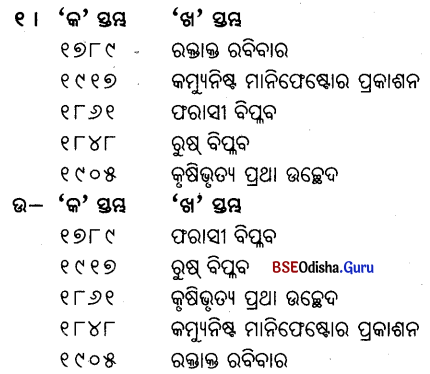
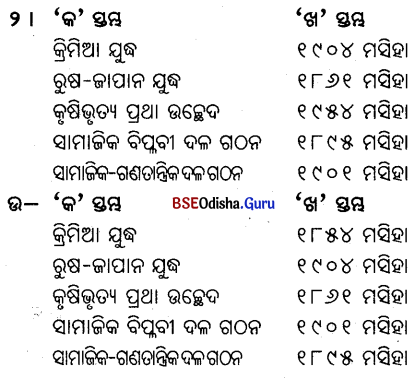
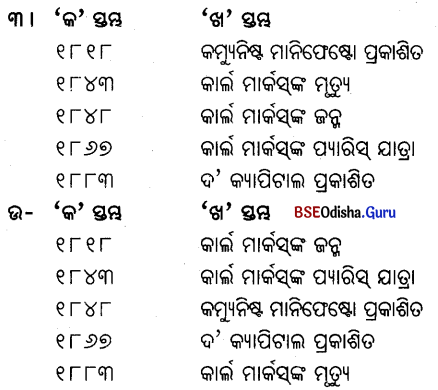

F ରେଖାଙ୍କିତ ପଦକୁ ପରିବର୍ତ୍ତନ କରି ଭ୍ରମ ସଂଶୋଧନ କର ।
୧। ଫରାସୀ ବିପ୍ଳବ ୧୯୧୭ ମସିହାରେ ହୋଇଥିଲା ।
Answer:
୧୭୮୯
୨ । ରୁଷିଆରେ ଶାସନର ସମସ୍ତ କ୍ଷମତା ସୁଲତାନଙ୍କ ହାତରେ କେନ୍ଦ୍ରୀଭୂତ ହୋଇଥିଲା ।
Answer:
ଜାର୍
![]()
୩। ଜାର୍ ଦ୍ଵିତୀୟ ଆଲେକଜାଣ୍ଡାରଙ୍କ ସମୟରେ ଜାର୍ ଶାସନ ବିରୋଧରେ ଲୋକମାନଙ୍କର ଅସନ୍ତୋଷ ଘନୀଭୂତ ହୋଇ ବିପ୍ଳବର ସୂତ୍ରପାତ ହୋଇଥିଲା ।
Answer:
ନିକୋଲାସ୍
୪୮ ୧୮୯୫ ମସିହାରେ ଅସନ୍ତୁଷ୍ଟ ଶିଳ୍ପପତିମାନେ ‘‘ସାମାଜିକ ଗଣତାନ୍ତ୍ରିକ ଦଳ’’ ଗଠନ କରିଥିଲେ ।
Answer:
ଶ୍ରମିକମାନେ
୫। ‘ରକ୍ତାକ୍ତ ରବିବାର’ ଜର୍ମାନୀ ଇତିହାସରେ ଏକ କଳଙ୍କିତ ଅଧ୍ୟାୟ ।
Answer:
ରୁଷ୍
୬। ରୁଷର ରାଣୀ ଆଲେକ୍ଜାଣ୍ଡାଙ୍କୁ ଇଟାଲୀର ରାଣୀ ମେରି ଏନ୍ତୋଇନେଙ୍କ ସହିତ ତୁଳନା କରାଯାଇଥାଏ ।
Answer:
ଫ୍ରାନ୍ସ
୭ । ଅକ୍ଟୋବର ବିପ୍ଲବରେ ଖାଦ୍ୟ ସମସ୍ୟା ଯୋଗୁଁ ପାଉଁରୁଟି ଭାଟି ଉପରେ ଆକ୍ରମଣ କରାଯାଇଥିଲା ।
Answer:
ଫେବୃୟାରୀ ବିପ୍ଳବ
୮ । ବୋଲସେଭିକ୍ ଦଳଦ୍ୱାରା ଫେବୃୟାରୀ ବିପ୍ଲବ ସଂଗଠିତ ଓ ପରିଚାଳିତ ହୋଇଥିଲା ।
Answer:
ଅକ୍ଟୋବର ବିପ୍ଲବ
୯। ରୁଷିଆରେ ନୂତନ ସମ୍ବିଧାନ ୧୯୧୮ ମସିହାରେ କାର୍ଯ୍ୟକାରୀ ହୋଇଥିଲା ।
Answer:
୧୯୨୪
୧୦ । ରୁଷିଆ ଓ ଜର୍ମାନୀ ମଧ୍ୟରେ ୧୯୧୮ ମସିହାରେ ଭର୍ସାଇ ସନ୍ଧି ସ୍ବାକ୍ଷରିତ ହୋଇଥିଲା ।
Answer:
ବ୍ରେଷ୍ଟ ଲିତୋଭସ୍କ ସନ୍ଧି
G ଚାରୋଟି ସମ୍ଭାବ୍ୟ ବିକଳ୍ପ ମଧ୍ୟରୁ ସଠିକ୍ ଉତ୍ତରଟି ବାଛି ଲେଖ ।
1. ପ୍ରଧାନମନ୍ତ୍ରୀ କେରେନ୍ସ୍କି ପୂର୍ବରୁ ରୁଷିଆ ମନ୍ତ୍ରୀମଣ୍ଡଳର କେଉଁ ବିଭାଗର ଦାୟିତ୍ଵରେ ଥିଲେ ?
(A) ଅର୍ଥ
(B) ଶିକ୍ଷା
(C) ବାଣିଜ୍ୟ
(D) ଯୁଦ୍ଧ
Answer:
(D) ଯୁଦ୍ଧ
2. ଅକ୍ଟୋବର ବିପ୍ଳବ ରୁଷିଆରେ କାହା ନେତୃତ୍ୱରେ ସଙ୍ଗଠିତ ହୋଇଥିଲା ?
(A) ଜାର୍ ନିକେଲାସ୍
(B) ଲିଓ ଟଲଷ୍ଟୟ
(C) କାର୍ଲ ମାର୍ଚ୍ଚ
(D) ଲେନିନ୍
Answer:
(D) ଲେନିନ୍
3. ଲେନିନ୍ ଓ ଟ୍ରଟସ୍କିଙ୍କ ନେତୃତ୍ୱରେ କେଉଁ ଦଳ କେରେନ୍ସ୍କି ସରକାରଙ୍କୁ କଠୋର ସମାଲୋଚନା କରିଥିଲା ?
(A) ମେସେଭିକ୍
(B) ବୋଲସେଭିକ୍
(C) ସମାଜବାଦୀ
(D) ସନ୍ତ୍ରାସବାଦୀ
Answer:
(B) ବୋଲସେଭିକ୍
![]()
4. କେବେ ରୁଷିଆର ନାମ ପରିବର୍ତ୍ତନ କରାଯାଇ ଏହାକୁ ‘ୟୁନିୟନ ଅଫ୍ ସୋଭିଏତ୍ ସୋସିଆଲିଷ୍ଟ ରିପବ୍ଲିକ୍ସ’ କୁହାଗଲା ?
(A) ୧୯୨୨
(B) ୧୯୨୩
(C) ୧୯୨୪
(D) ୧୯୨୫
Answer:
(C) ୧୯୨୪
5. ରୁଷିଆ ଓ ଜର୍ମାନୀ ମଧ୍ୟରେ କେବେ ବ୍ରେଷ୍ଟ-ଲିତୋଭ୍ସ୍କ ସନ୍ଧି ସ୍ବାକ୍ଷରିତ ହୋଇଥିଲା ?
(A) ୧୯୧୫
(B) ୧୯୧୬
(C) ୧୯୧୭
(D) ୧୯୧୮
Answer:
(C) ୧୯୧୭
6. ‘କାର୍ଲମାର୍ଚ୍ଚ’ ନିମ୍ନୋକ୍ତ କେଉଁ ଦେଶରେ ଜନ୍ମଗ୍ରହଣ କରିଥିଲେ ?
(A) ଇଟାଲୀ
(B) ଜର୍ମାନୀ
(C) ରୁଷ୍
(D) ଫ୍ରାନ୍ସ
Answer:
(B) ଜର୍ମାନୀ
7. କେଉଁ ଖ୍ରୀଷ୍ଟାବ୍ଦରେ ରୁଷ୍ ଜାପାନଠାରୁ ପରାସ୍ତ ହୋଇଥିଲା ?
(A) ୧୯୦୪
(B) ୧୯୦୫
(C) ୧୯୧୦
(D) ୧୯୧୧
Answer:
(A) ୧୯୦୪
8. ଲେନିନ୍ କେଉଁ ଦଳର ନେତା ଥିଲେ ?
(A) ମେନେସେଭିକ୍
(B) ବୋଲ୍ ସେଭିକ୍
(C) ସାମ୍ୟବାଦୀ
(D) ସମାଜବାଦୀ
Answer:
(B) ବୋଲ୍ ସେଭିକ୍
9. ପେଟ୍ରୋଗ୍ରାଡ଼ ସହରଟିର ଆଧୁନିକ ନାମ କ’ଣ ?
(A) ମସ୍କୋ
(B) ତାସ୍କେଣ୍ଡ
(C) ୟୁକ୍ରେନ୍
(D) ଲେନିନ୍ଙ୍ଗ୍ରାଙ୍
Answer:
(D) ଲେନିନ୍ଙ୍ଗ୍ରାଙ୍
10. ରୁଷ୍ ଦେଶର ବର୍ଷ ପଞ୍ଜିକାନୁସାରେ ‘ଅକ୍ଟୋବର ବିପ୍ଳବ’ କେବେ ସଂଘଟିତ ହୋଇଥିଲା ?
(A) ଅକ୍ଟୋବର ୧
(B) ଅକ୍ଟୋବର ୧୦
(C) ଅକ୍ଟୋବର ୨୫
(D) ଅକ୍ଟୋବର ୧୫
Answer:
(C) ଅକ୍ଟୋବର ୨୫
11. ରୁଷ୍ ବିପ୍ଳବଦ୍ଵାରା ପୃଥିବୀର ବହୁ ଦେଶର ଜନସାଧାରଣ କେଉଁ ଆଦର୍ଶଦ୍ବାରା ପ୍ରଭାବିତ ହୋଇଥିଲେ ?
(A) ସାମ୍ୟବାଦ
(B) ଫାସୀବାଦ
(C) ସମାଜବାଦ
(D) ନାଜୀବାଦ
Answer:
(A) ସାମ୍ୟବାଦ
12. କେରେନ୍ସ୍କି ସରକାରର ପତନ ରୁଷ୍ଠରେ କେଉଁ ବିପ୍ଳବ ଭାବେ ଖ୍ୟାତ ?
(A) ଅଗଷ୍ଟ ବିପ୍ଳବ
(B) ଫେବୃଆରୀ ବିପ୍ଳବ
(C) ଅକ୍ଟୋବର ବିପ୍ଳବ
(D) ଜୁଲାଇ ବିପ୍ଳବ
Answer:
(C) ଅକ୍ଟୋବର ବିପ୍ଳବ
13. ଅକ୍ଟୋବର ବିପ୍ଳବ ସମୟରେ ଇଂରାଜୀ ବର୍ଷ-ପଞ୍ଜିକା ଓ ରୁଷ୍ ବର୍ଷ-ପଞ୍ଜିକା ମଧ୍ୟରେ କେତେ ଦିନର ବ୍ୟବଧାନ ଥିଲା ?
(A) ୩୦ ଦିନ
(B) ୨୦ ଦିନ
(C) ୧୫ ଦିନ
(D) ୧୩ ଦିନ
Answer:
(D) ୧୩ ଦିନ
![]()
14. ନିମ୍ନୋକ୍ତ ମଧ୍ଯରୁ କେଉଁ ବର୍ଷ ରୁଷ୍ ପ୍ରଥମ ବିଶ୍ବଯୁଦ୍ଧରୁ ଓହରିଗଲା ?
(A) ୧୯୧୫
(B) ୧୯୧୬
(C) ୧୯୧୭
(D) ୧୯୧୮
Answer:
(C) ୧୯୧୭
15. ନିମ୍ନୋକ୍ତ କେଉଁ ଦେଶରେ ‘ଜାର୍’ ଉପାଧ୍ଧରୀ ସମ୍ରାଟମାନେ ଶାସନ କରୁଥିଲେ ?
(A) ଚୀନ୍
(B) ଜର୍ମାନୀ
(C) ରୁଷ୍
(D) ଜାପାନ
Answer:
(C) ରୁଷ୍
16. ରୁଷ୍ ବିପ୍ଳବ ପୂର୍ବରୁ ରୁଷ୍ ସମାଜ ମୁଖ୍ୟତଃ କେତୋଟି ଶ୍ରେଣୀର ବିଭକ୍ତ ଥୁଲା ?
(A) ୨
(B) ୩
(C) 8
(D) ୫
Answer:
(A) ୨
17. କାର୍ଲ ମାର୍କଙ୍କଦ୍ବାରା ବୈପ୍ଳବିକ ଚିନ୍ତାଧାରା ସମ୍ବଳିତ ପ୍ରସିଦ୍ଧ ପୁସ୍ତିକା ‘କମ୍ୟୁନିଷ୍ଟ ମାନିଫେଷ୍ଟା’ କେଉଁ ମସିହାରେ ପ୍ରକାଶିତ ହୋଇଥିଲା ?
(A) ୧୮୪୮
(B) ୧୮୫୨
(C) ୧୮୫୦
(D) ୧୮୫୮
Answer:
(A) ୧୮୪୮
18. ‘କାର୍ଲମାର୍କ’ ନିମ୍ନୋକ୍ତ କେଉଁ ମସିହାରେ ଜନ୍ମଗ୍ରହଣ କରିଥିଲେ ?
(A) ୧୮୧୮
(B) ୧୮୫୫
(C) ୧୮୫୩
(D) ୧୮୨୧
Answer:
(A) ୧୮୧୮
19. ନିମ୍ନୋକ୍ତ କେଉଁ ମସିହାରେ ଅସନ୍ତୁଷ୍ଟ ଶ୍ରମିକମାନେ ‘ସାମାଜିକ ଗଣତାନ୍ତ୍ରିକ ଦଳ’ ଗଠନ କରିଥେଲେ ?
(A) ୧୮୯୧
(B) ୧୮୯୫
(C) ୧୮୯୪
(D) ୧୮୯୮
Answer:
(B) ୧୮୯୫
20. ନିମ୍ନୋକ୍ତ କେଉଁ ମସିହାରେ ଭୂମିହୀନ କୃଷକମାନେ ‘ସାମାଜିକ ବିପ୍ଳବୀ ଦଳ’ ଗଠନ କରିଥିଲେ ?
(A) ୧୯୧୨
(B) ୧୯୦୧
(C) ୧୯୦୯
(D) ୧୯୦୦
Answer:
(B) ୧୯୦୧
21. ଲେନିନ୍ ନିମ୍ନୋକ୍ତ କେଉଁ ମସିହାରେ ଜନ୍ମଗ୍ରହଣ କରିଥିଲେ ?
(A) ୧୮୭୦
(B) ୧୮୭୫
(C) ୧୮୭୨
(D) ୧୮୮୦
Answer:
(A) ୧୮୭୦
22. ‘ପ୍ରୋଲୋତାରିଏତ୍’ କହିଲେ କେଉଁ ଗୋଷ୍ଠୀକୁ ବୁଝାଏ ?
(A) ଶ୍ରମିକ ଗୋଷ୍ଠୀ
(B) ସର୍ବହରା ଗୋଷ୍ଠୀ
(C) କୃଷକ ଗୋଷ୍ଠୀ
(D) ମହିଳା ଗୋଷ୍ଠୀ
Answer:
(B) ସର୍ବହରା ଗୋଷ୍ଠୀ
23. କିଏ ରୁଷିଆ ଚର୍ଚ୍ଚାର ମୁଖ୍ୟ ଥିଲେ ?
(A) ଫାଦର
(B) ଲିଡ଼ର
(C) ଜାର୍
(D) ବିଶପ୍
Answer:
(C) ଜାର୍
![]()
24. କାର୍ମାନେ ଅପରାଧୀମାନଙ୍କୁ ସୁଦୂର ବରଫାବୃତ୍ତ କେଉଁ ଅଞ୍ଚଳକୁ ନିର୍ବାଚନ କରୁଥିଲେ ?
(A) ଲାଇବେରିଆ
(B) ସାଇବେରିଆ
(C) ପିଟରଗ୍ରାଡ଼୍
(D) ସାଇପ୍ରସ୍
Answer:
(B) ସାଇବେରିଆ
25. ରୁଷ୍ ଦେଶର ଗରିବ ଶ୍ରମିକ ଓ କୃଷକମାନେ କେଉଁ ନିଶାକାରୀ ପାନୀୟ ପ୍ରତି ଆସକ୍ତ ଥିଲେ ?
(A) ଭୋଦ୍
(B) ସାମ୍ପେନ୍
(C) କଣ୍ଟେଲ
(D) ହୁଇସ୍କି
Answer:
(A) ଭୋଦ୍
26. ଜାର୍ ଦ୍ୱିତୀୟ ଆଲେକ୍ଜାଣ୍ଡର କେବେ କୃଷିଭୃତ୍ୟ ପ୍ରଥାର ଉଚ୍ଛେଦ କରିଥିଲେ ?
(A) ୧୮୬୦ ମସିହା
(B) ୧୮୬୧ ମସିହା
(C) ୧୮୬୨ ମସିହା
(D) ୧୮୬୫ ମସିହା
Answer:
(B) ୧୮୬୧ ମସିହା
27. ‘ଦ କ୍ୟାପିଟାଲ୍’ (Das Kapital) ପୁସ୍ତକ କିଏ ରଚନା କରିଥିଲେ ?
(A) କାର୍ଲମାର୍ଚ୍ଚ
(B) ଫ୍ରେଡ୍ରିକ ଏଞ୍ଜେଲ୍
(C) ଲିଓ ଟଲଷ୍ଟ ଏ
(D) ମାକ୍ସିମ୍ ଗୋକି
Answer:
(A) କାର୍ଲମାର୍ଚ୍ଚ
28. ରୁଷିଆ କେବେ କ୍ଷୁଦ୍ର ଦେଶ ଜାପାଦ୍ୱାରା ପରାଜିତ ହୋଇଥିଲା ?
(A) ୧୮୯୫ ମସିହା
(B) ୧୯୦୧ ମସିହା
(C) ୧୯୦୪ ମସିହା
(D) ୧୯୦୭ ମସିହା
Answer:
(C) ୧୯୦୪ ମସିହା

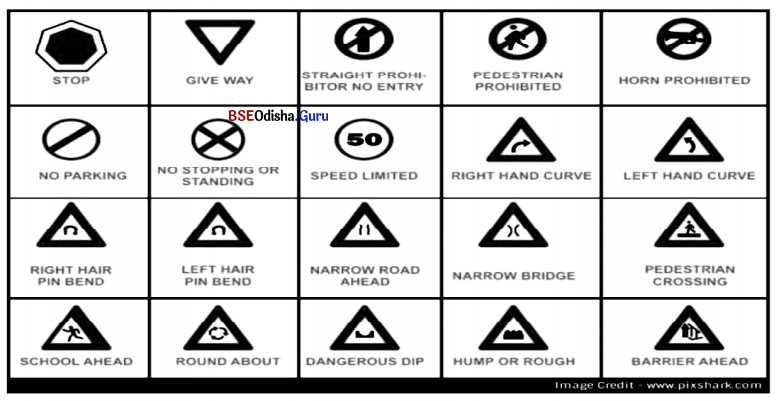
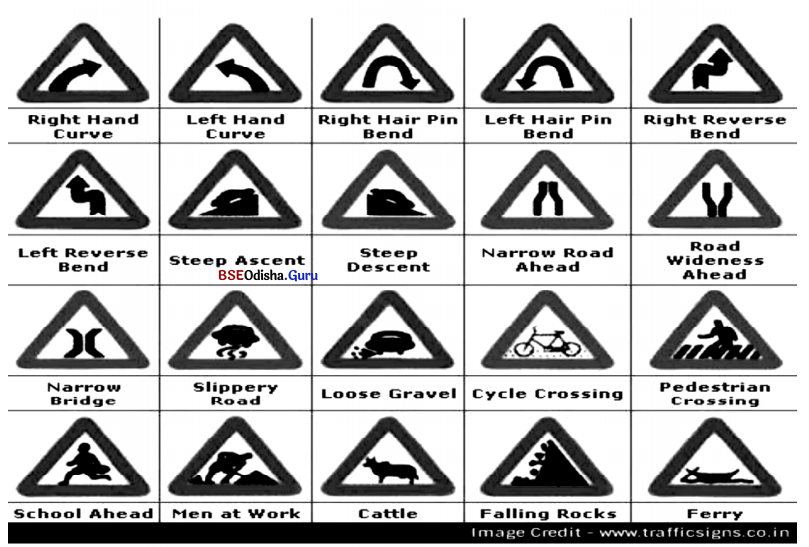
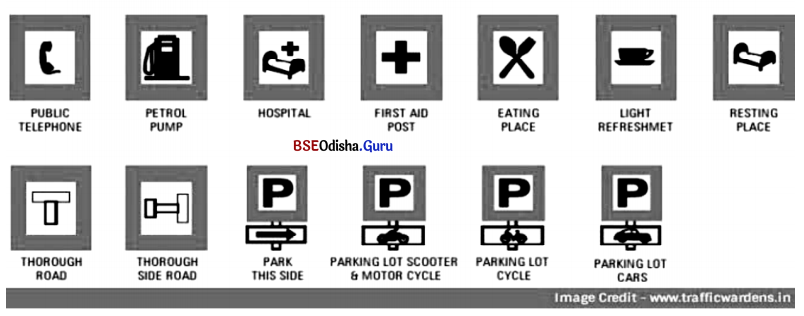
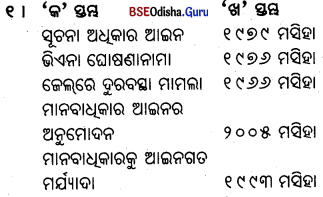
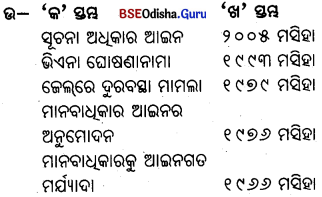
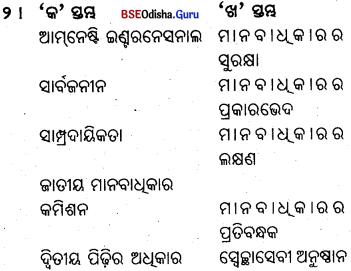
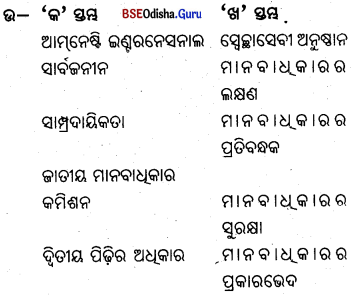
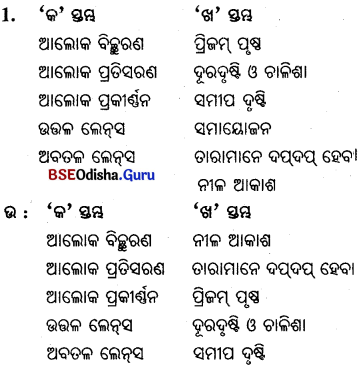
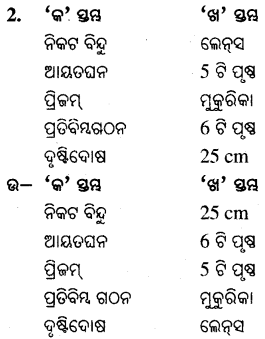
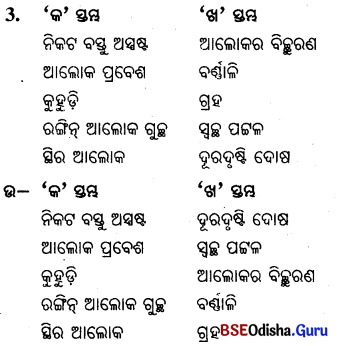
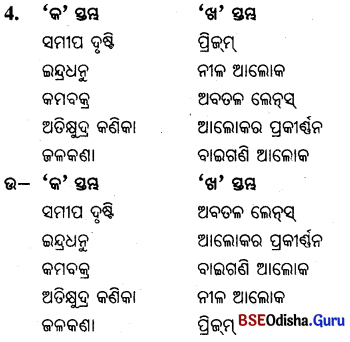


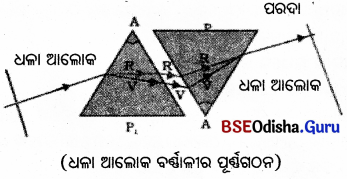
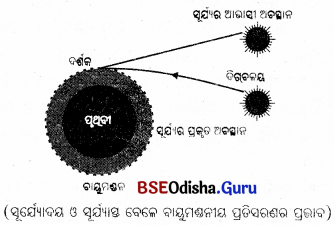
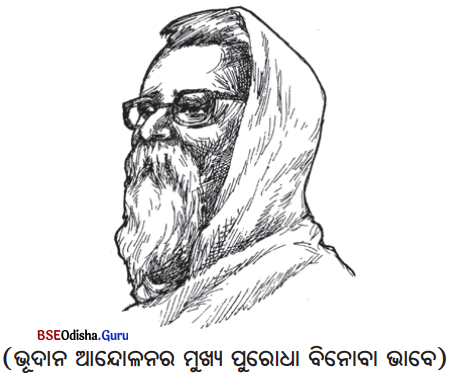
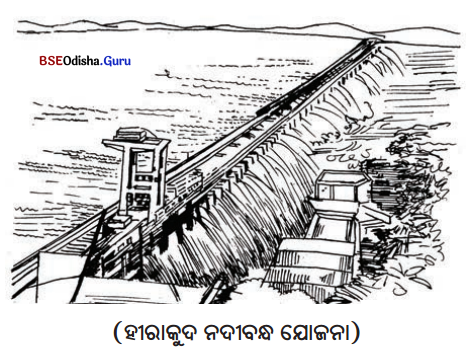
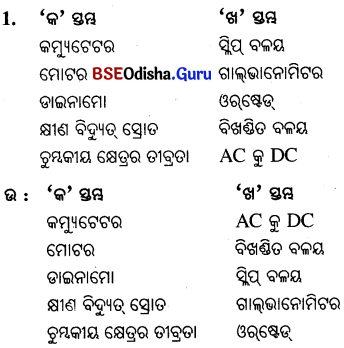
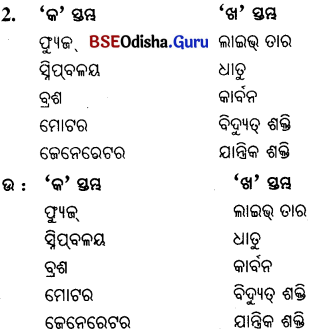
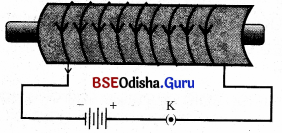
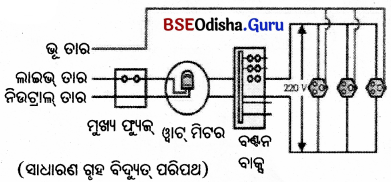

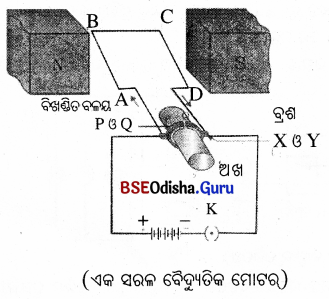
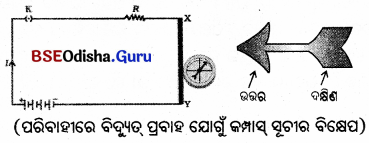
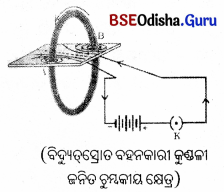
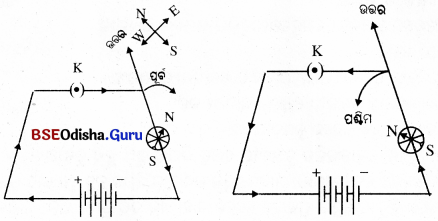
 α କଣିକା ।
α କଣିକା ।
